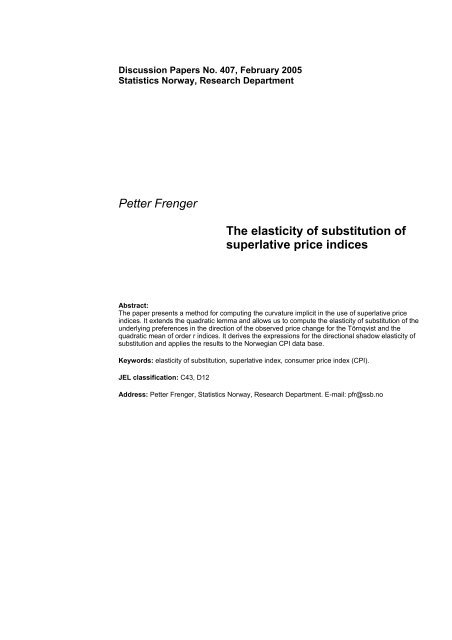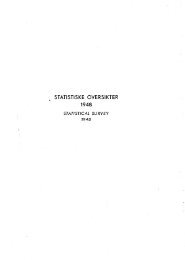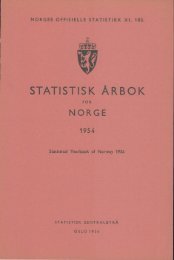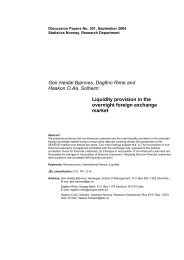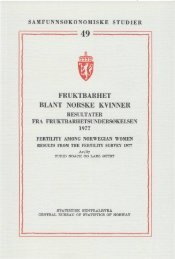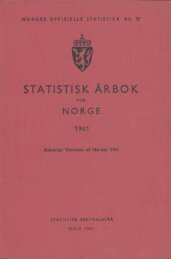Petter Frenger The elasticity of substitution of superlative price indices
Petter Frenger The elasticity of substitution of superlative price indices
Petter Frenger The elasticity of substitution of superlative price indices
You also want an ePaper? Increase the reach of your titles
YUMPU automatically turns print PDFs into web optimized ePapers that Google loves.
Discussion Papers No. 407, February 2005<br />
Statistics Norway, Research Department<br />
<strong>Petter</strong> <strong>Frenger</strong><br />
<strong>The</strong> <strong>elasticity</strong> <strong>of</strong> <strong>substitution</strong> <strong>of</strong><br />
<strong>superlative</strong> <strong>price</strong> <strong>indices</strong><br />
Abstract:<br />
<strong>The</strong> paper presents a method for computing the curvature implicit in the use <strong>of</strong> <strong>superlative</strong> <strong>price</strong><br />
<strong>indices</strong>. It extends the quadratic lemma and allows us to compute the <strong>elasticity</strong> <strong>of</strong> <strong>substitution</strong> <strong>of</strong> the<br />
underlying preferences in the direction <strong>of</strong> the observed <strong>price</strong> change for the Törnqvist and the<br />
quadratic mean <strong>of</strong> order r <strong>indices</strong>. It derives the expressions for the directional shadow <strong>elasticity</strong> <strong>of</strong><br />
<strong>substitution</strong> and applies the results to the Norwegian CPI data base.<br />
Keywords: <strong>elasticity</strong> <strong>of</strong> <strong>substitution</strong>, <strong>superlative</strong> index, consumer <strong>price</strong> index (CPI).<br />
JEL classification: C43, D12<br />
Address: <strong>Petter</strong> <strong>Frenger</strong>, Statistics Norway, Research Department. E-mail: pfr@ssb.no
Discussion Papers comprise research papers intended for international journals or books. A preprint <strong>of</strong> a<br />
Discussion Paper may be longer and more elaborate than a standard journal article, as it<br />
may include intermediate calculations and background material etc.<br />
Abstracts with downloadable Discussion Papers<br />
in PDF are available on the Internet:<br />
http://www.ssb.no<br />
http://ideas.repec.org/s/ssb/dispap.html<br />
For printed Discussion Papers contact:<br />
Statistics Norway<br />
Sales- and subscription service<br />
NO-2225 Kongsvinger<br />
Telephone: +47 62 88 55 00<br />
Telefax: +47 62 88 55 95<br />
E-mail: Salg-abonnement@ssb.no
1. Introduction<br />
<strong>The</strong> theory <strong>of</strong> exact and <strong>superlative</strong> <strong>price</strong> <strong>indices</strong> has shown that we are able, in certain<br />
situations, to recover the change in the cost <strong>of</strong> living index from observations on <strong>price</strong>s<br />
and commodity purchases in the comparison and the base periods, data which are readily<br />
available to statistical agencies compiling cost <strong>of</strong> living <strong>indices</strong>. <strong>The</strong> applied work has<br />
used extensively on the family <strong>of</strong> quadratic mean <strong>of</strong> order r functions and in particular<br />
the special cases, the Törnqvist index and the Fisher ideal index, and the pro<strong>of</strong> <strong>of</strong> their<br />
ability to recover the true index has relied on the quadratic (approximation) lemma which<br />
completely characterizes quadratic functions as shown by Diewert (1976, 2002).<br />
<strong>The</strong> thrust <strong>of</strong> the present paper is that the quadratic lemma, together with the use<br />
<strong>of</strong> the Törnqvist or the quadratic mean <strong>of</strong> order r <strong>indices</strong>, is able to provide us with<br />
information about the second order or curvature properties <strong>of</strong> the underlying preferences.<br />
By using an extension <strong>of</strong> the quadratic lemma with the directional shadow <strong>elasticity</strong> <strong>of</strong><br />
<strong>substitution</strong> (DSES), a concept introduced by the author in <strong>Frenger</strong> (1978, 1985), as the<br />
measure <strong>of</strong> curvature, the main result <strong>of</strong> the paper is the derivation <strong>of</strong> explicit formulae<br />
for the DSES <strong>of</strong> the underlying preferences for the translog and the quadratic mean <strong>of</strong><br />
order r expenditure functions [see (23) and (33) below]. <strong>The</strong>se elasticities, however, can<br />
only be computed in the direction <strong>of</strong> the observed <strong>price</strong> change, since that is all the data<br />
will permit. I have included some numerical examples <strong>of</strong> the method based on Norwegian<br />
data.<br />
<strong>The</strong> paper is rather technical, but it would appear to have important implications for<br />
empirical work on <strong>price</strong> <strong>indices</strong>, as the numerical examples illustrate, particularly when<br />
one recognizes that the DSES may be interpreted as a local measure <strong>of</strong> the <strong>substitution</strong><br />
bias. <strong>The</strong> last decade has seen a great interest in many countries in revising the methodology<br />
for computing the consumer <strong>price</strong> index (CPI) in a way that better allows for the<br />
commodity <strong>substitution</strong> which occurs as consumers alter their purchasing patterns in response<br />
to changing <strong>price</strong>s. <strong>The</strong> Boskin Commission (1996, p. iii) recommends that the<br />
“CPI should move toward a COLI concept by adopting a ‘<strong>superlative</strong>’ index formula to<br />
account for changing market baskets”. More recently another committee, Schultze and<br />
Mackie (2002, p. 6), concludes that “<strong>The</strong> BLS should publish, contemporaneous with the<br />
real-time CPI, an advance estimate <strong>of</strong> the <strong>superlative</strong> index, utilizing either a constant<strong>elasticity</strong>-<strong>of</strong>-<strong>substitution</strong><br />
method or some other technique.” Shapiro and Wilcox (1997)<br />
propose a method based on the CES function for extending <strong>superlative</strong> <strong>indices</strong> outside the<br />
observation period.<br />
<strong>The</strong> discussion <strong>of</strong> <strong>superlative</strong> <strong>indices</strong> or flexible functional forms has <strong>of</strong>ten been presented<br />
as a choice between the Törnqvist (or translog) index and Fisher’s ideal index.<br />
Alternatively one talks about <strong>substitution</strong> bias as the difference in measured inflation resulting<br />
from the use <strong>of</strong> the traditional Laspeyres index and either <strong>of</strong> the above <strong>indices</strong>. One<br />
<strong>of</strong> the problems with this debate is that we have no generally accepted way <strong>of</strong> measuring<br />
<strong>substitution</strong> or, as I tend to view it, the curvature <strong>of</strong> the underlying indifference surface<br />
along which the cost <strong>of</strong> living index (COLI) is measured. In a recent paper <strong>Frenger</strong> (2005)<br />
analyzes the definition <strong>of</strong> the <strong>substitution</strong> bias and the relationship between the bias and<br />
the <strong>elasticity</strong> <strong>of</strong> <strong>substitution</strong>.<br />
3
<strong>The</strong> next three sections introduce the concepts needed to derive the main results <strong>of</strong><br />
the paper. Section 2 reminds the reader <strong>of</strong> the definitions <strong>of</strong> exact and <strong>superlative</strong> <strong>indices</strong><br />
and presents the quadratic mean <strong>of</strong> order r family <strong>of</strong> <strong>price</strong> <strong>indices</strong>. Section 3 introduces<br />
the quadratic lemma and an extension which permits us to characterize the second order<br />
properties <strong>of</strong> the quadratic function on the basis <strong>of</strong> the gradient only. In section 4 I define<br />
the directional shadow <strong>elasticity</strong> <strong>of</strong> <strong>substitution</strong> (DSES) which provides a measure <strong>of</strong> the<br />
<strong>elasticity</strong> <strong>of</strong> <strong>substitution</strong> <strong>of</strong> the underlying preferences for an arbitrary <strong>price</strong> change, such<br />
as the <strong>price</strong> change from the base period to the comparison period. With these tools<br />
at hand, we are then ready for the calculation <strong>of</strong> the expressions for the DSESs for the<br />
translog expenditure function (and the Törnqvist index) in section 5 and the quadratic<br />
mean <strong>of</strong> order r expenditure function in section 6. Each <strong>of</strong> these sections includes numerical<br />
examples based on Norwegian CPI data. <strong>The</strong> basic ideas and procedures are introduced<br />
in section 5 on the translog function and permit the derivation <strong>of</strong> the expression for the<br />
DSES in (23) and the calculation <strong>of</strong> the numerical example in the last column <strong>of</strong> table 1.<br />
<strong>The</strong> procedure is essentially repeated in the r-mean case (which in principle includes the<br />
translog function), but in this case we are also able to analyze the effect <strong>of</strong> altering the r<br />
parameter as illustrated in figure 2. <strong>The</strong> paper ends with some concluding comments.<br />
2. Exact and <strong>superlative</strong> <strong>price</strong> <strong>indices</strong><br />
We will follow the standard practice in the applied theory <strong>of</strong> cost <strong>of</strong> living <strong>indices</strong> and<br />
assume there is a single representative consumer with homothetic preference, which may<br />
be represented dually by the expenditure function C(u, p) =uc(p) giving the minimum<br />
expenditure necessary to reach the utility level u when the <strong>price</strong>s are p =(p1,...,pn).<br />
<strong>The</strong> function c is the unit expenditure function, which we assume to possess the standard<br />
neoclassical properties, in particular monotonicity, linear homogeneity, quasiconcavity,<br />
and twice continuous differentiability in p for p>0. Let cp =[c1,...,cn] and cpp =<br />
[cij]i,j=1,...,n denote the gradient and the Hessian matrix <strong>of</strong> the unit expenditure function.<br />
Shephard’s lemma implies that the constant utility (u = 1) Hicksian demand function are<br />
xi = ∂c(p)/∂pi = ci(p), i =1,...,n or x = cp(p). Many <strong>of</strong> the expressions below will be<br />
simplified by the introduction <strong>of</strong> the value shares si = pixi/ �<br />
j pjxj.<br />
By definition the true (or Konüs) cost <strong>of</strong> living index,<br />
P ∗ (p 1 ,p 0 ) = c(p1 )<br />
c(p 0 ) ,<br />
is the ratio <strong>of</strong> the minimum expenditure needed in the comparison period t1 to maintain<br />
the same level <strong>of</strong> utility (in the present case u = 1) as in the base period t0. <strong>The</strong> function<br />
c is in general unknown and we tend to approximate the true index with <strong>price</strong> <strong>indices</strong><br />
<strong>of</strong> the form P (p 1 ,x 1 ; p 0 ,x 0 ), which are functions <strong>of</strong> the <strong>price</strong> and consumption vectors in<br />
the two periods. <strong>The</strong>se are typically the data which are available for the construction <strong>of</strong><br />
consumer <strong>price</strong> <strong>indices</strong> from annual consumer surveys and monthly <strong>price</strong> sampling.<br />
4
Occasionally we find ourself in the fortunate situation <strong>of</strong> being able to recover the true<br />
cost <strong>of</strong> living index:<br />
Definition. Consider the unit expenditure function c(p) and the <strong>price</strong> index function<br />
P (p 1 ,x 1 ; p 0 ,x 0 ). <strong>The</strong> <strong>price</strong> index function P is exact for c if<br />
P (p 1 ,x 1 ; p 0 ,x 0 ) = c(p1 )<br />
c(p 0 ) ,<br />
for all p 1 ,p 2 in R n + and x t = cp(p t ), t =1, 2. 1<br />
Note that it is required that the commodity demand vectors x 0 and x 1 be optimal at the<br />
respective <strong>price</strong>s.<br />
<strong>The</strong> concept <strong>of</strong> an exact index is both intuitive and useful: the information provided<br />
by observations on <strong>price</strong> and quantity at two different periods is sufficient to recover<br />
the change in the value <strong>of</strong> the underlying function. As defined above the exact index is a<br />
function from R 4n<br />
+ into R+. In practice, however, the definition is also applied to functions<br />
defined on a subset <strong>of</strong> R 4n<br />
+ , and to functions defined on R 4n<br />
+ and some additional parameter<br />
space.<br />
An example <strong>of</strong> an exact index is provided by the CES index<br />
P CES (p 1 ,p 0 ,x 0 ) =<br />
� n �<br />
i=1<br />
s 0 i<br />
� p 1 i<br />
p 0 i<br />
� 1−σ� 1<br />
1−σ<br />
which is exact for the CES unit expenditure function with σ as <strong>substitution</strong> parameter. It<br />
was introduced by Lloyd (1975) and recently popularized by Shapiro and Wilcox (1997) as<br />
a way <strong>of</strong> constructing a real-time index which allows for <strong>substitution</strong> possibilities. Schultze<br />
and Mackie (2002) have recently recommended that the Bureau <strong>of</strong> Labor Statistics publish<br />
“an advance estimate <strong>of</strong> the <strong>superlative</strong> index, utilizing either a constant-<strong>elasticity</strong>-<strong>of</strong><strong>substitution</strong><br />
method or some other technique.” 2<br />
<strong>The</strong> introduction <strong>of</strong> the Generalized Leontief [Diewert (1971)] and the translog [Christensen,<br />
Jorgenson, and Lau (1971, 1973)] functional forms supplied the econometrician<br />
with functions that were richly enough parametrized to provide a second order approximation<br />
an arbitrary function at any given point. This led to the concept <strong>of</strong> flexibility <strong>of</strong><br />
a function. A unit expenditure function c is flexible if its capable <strong>of</strong> providing a second<br />
order (differential) approximation to an arbitrary twice continuously differentiable unit<br />
expenditure function at any point in its domain. Extending this concept to <strong>indices</strong> we say<br />
that:<br />
Definition. A <strong>price</strong> index P (p 1 ,x 1 ; p 0 ,x 0 )is<strong>superlative</strong> if it is exact for a flexible unit<br />
expenditure function c.<br />
1<br />
See Diewert (1976). See also Diewert (1981), section 6 on “Superlative index number formulae” and<br />
Diewert’s Palgrave article [Diewert (1987), pp. 772–3].<br />
2<br />
Schultze and Mackie (2002), Executive Summary, p. 6, Recommendation 7-1.<br />
5<br />
,
Among the most widely used <strong>superlative</strong> <strong>indices</strong> are the <strong>The</strong> Törnqvist <strong>price</strong> index,<br />
P 0 (p 1 ,x 1 ; p 0 ,x 0 ) =<br />
n�<br />
�<br />
p1 i<br />
i=1<br />
p 0 i<br />
�1 2 (s 0 i +s1 i )<br />
and the quadratic mean <strong>of</strong> order r <strong>price</strong> index 3<br />
P r (p 1 ,x 1 ; p 0 ,x 0 ) =<br />
⎡<br />
⎢<br />
⎣<br />
n�<br />
i=1<br />
n�<br />
i=1<br />
s 0 i<br />
s 1 i<br />
� p 1 i<br />
p 0 i<br />
� p 0 i<br />
p 1 i<br />
�r<br />
2<br />
�r<br />
2<br />
⎤<br />
⎥<br />
⎦<br />
1<br />
r<br />
, s t i = pti xt � i<br />
j pt jxt j<br />
, s t i = pti xt � i<br />
j pt jxt j<br />
, t =0, 1, (1)<br />
, t =0, 1, r �= 0.<br />
<strong>The</strong>se two <strong>indices</strong> will be analyzed at length in sections 5 and 6 below, where we also show<br />
that the <strong>indices</strong> themselves provide a second order approximation in the direction <strong>of</strong> the<br />
observed <strong>price</strong> change.<br />
For r = 2, the quadratic mean <strong>of</strong> order 2 reduces to the Fisher ideal index<br />
P 2 (p 1 ,x 1 ; p 0 ,x 0 ) =<br />
⎡<br />
⎢<br />
⎣<br />
n�<br />
i=1<br />
n�<br />
i=1<br />
which is also the square root <strong>of</strong> the product <strong>of</strong> the Laspeyres and Paasche <strong>indices</strong>. <strong>The</strong><br />
quadratic mean <strong>of</strong> order r <strong>price</strong> index P r and the Törnqvist index P 0 are essentially<br />
members <strong>of</strong> the same family <strong>of</strong> <strong>superlative</strong> <strong>indices</strong> since P 0 is the limit <strong>of</strong> P r as r → 0. 4<br />
3. <strong>The</strong> quadratic lemma<br />
<strong>The</strong> quadratic lemma was introduced into the theory <strong>of</strong> index numbers by Diewert<br />
(1976, p. 118), who calls it the “quadratic approximation lemma” even though no “approximation”<br />
seems to be involved. And in fact he uses it to prove that the Törnqvist<br />
index is exact. Once we know that the function is quadratic we know a good deal more<br />
about it than what is revealed by the quadratic lemma, and these facts are summarized<br />
in the extended quadratic lemma below.<br />
Consider the quadratic function<br />
f(z) = a0 + a ′ z + 1<br />
2 z′ Az , (3)<br />
p 1 i x 0 i<br />
p 0 i x 0 i<br />
n�<br />
i=1<br />
n�<br />
i=1<br />
p 1 i x 1 i<br />
p 0 i x 1 i<br />
3 See Diewert (1976, eq. 4.5, p. 131) and theorem 4.11, p. 133.<br />
4 Diewert (1980, p. 451) proves the result for the corresponding expenditure functions.<br />
6<br />
⎤<br />
⎥<br />
⎦<br />
1<br />
2<br />
,<br />
(2)
where a0, a =[ai], and A =[aij] are constants, and A is a symmetric matrix. <strong>The</strong> function<br />
f is defined for all z ∈ R n . <strong>The</strong> gradient and the Hessian <strong>of</strong> the quadratic function (3) are<br />
given by:<br />
fz = ∇f = a + Az ,<br />
fzz = ∇ 2 f = A,<br />
the Hessian being in this case constant.<br />
Assume that we are given two points z 0 and z 1 in R n and the gradients ∇f(z 0 ) and<br />
∇f(z 1 ) at these points. This information is essentially sufficient to characterize fully the<br />
behavior <strong>of</strong> the quadratic function f along the line<br />
ℓ = { z | z = z 0 + t (z 1 − z 0 ) for some t ∈ R } ,<br />
z(t) = z 0 + t (z 1 − z 0 ) , t ∈ R,<br />
through z 0 and z 1 , as formalized in lemma 2 below. To start with we may note that the<br />
expression for the gradient implies that<br />
∇f(z 1 ) −∇f(z 0 ) = A (z 1 − z 0 ) , (5)<br />
showing that important information about the second order properties <strong>of</strong> the quadratic<br />
function f in the direction z 1 −z 0 is contained in the difference between the gradients at<br />
these points. In particular it implies that we need not know the elements <strong>of</strong> the A matrix.<br />
<strong>The</strong> quadratic lemma demonstrates that we can recover the change in the value <strong>of</strong> the<br />
function f from the knowledge <strong>of</strong> the gradient at two different points in its domain, once<br />
we know that it is quadratic. 5<br />
Lemma 1. Quadratic lemma. Let f be a continuously differentiable function defined<br />
on D ⊂ Rn , and let ∇f(zl ) denote the gradient <strong>of</strong> f evaluated at zl ∈ D, l =0, 1. <strong>The</strong>n f<br />
is the quadratic function defined by (3) if and only if<br />
f(z 1 ) − f(z 0 ) = 1 � � 0 1 ′ 1 0<br />
∇f(z )+∇f(z ) (z − z ) ,<br />
2<br />
for all z 0 and z 1 in D. 6<br />
Diewert (1976, p. 116), points out that the assumption that the function is quadratic<br />
and the use <strong>of</strong> the associated exact index implies that “we do not have to estimate the<br />
unknown coefficients in the A [coefficient] matrix.” We do in fact know exactly how much<br />
the function changes in value from z 0 to z 1 . But we know more: we know the change in<br />
the value <strong>of</strong> the function along the whole line segment through z 0 and z 1 , and we know<br />
the gradient and the “second derivative” along this line segment as the following lemma<br />
shows.<br />
5 <strong>The</strong> condition <strong>of</strong> the lemma was used extensively by Bowley (1928, p. 225), Frisch (1936, pp. 27–8),<br />
and Wald (1939, p. 321) in their attempts to develop a <strong>price</strong> index consistent with a non-homothetic utility<br />
function.<br />
6 For pro<strong>of</strong> see Diewert (1976, p. 138) and Lau (1979).<br />
7<br />
(4)
Lemma 2. Extended quadratic lemma. Let f be the quadratic function (3), let<br />
z 0 ,z 1 ∈ R n , and let z(t) =z 0 + t (z 1 −z 0 ), t ∈ R, be a point on the line through z 0 and<br />
z 1 . <strong>The</strong>n<br />
1) the value <strong>of</strong> f at z = z(t) is<br />
f(z) − f(z 0 ) = t ∇f(z 0 ) ′ (z 1 −z 0 )+ 1<br />
2 t2� ∇f(z 1 ) −∇f(z 0 ) � ′ (z 1 −z 0 ) ,<br />
2) the gradient at f at z is<br />
∇f(z) = ∇f(z 0 )+t � ∇f(z 1 ) −∇f(z 0 ) � .<br />
3) the covariant derivative <strong>of</strong> ∇f at z 0 in the direction z 1 − z 0 is<br />
� ¯∇z 1 −z 0 ∇f � (z 0 ) = ∇f(z 1 ) −∇f(z 0 ) .<br />
<strong>The</strong> first two properties recover the change in the value <strong>of</strong> the function and the gradient<br />
<strong>of</strong> f along the whole line ℓ, not just at z 0 and z 1 . <strong>The</strong> third property shows that we also<br />
know the “second derivative” <strong>of</strong> f along the line segment through z 0 and z 1 .<br />
To make more precise this notion <strong>of</strong> a directional second derivative we have to borrow<br />
some concepts from differential geometry. <strong>The</strong> first derivative <strong>of</strong> the real-valued function<br />
f at z is represented by the gradient ∇f(z) =(f1(z),...,fn(z)), which is a vector in R n .<br />
Considered as a function <strong>of</strong> z, the gradient ∇f forms a vector field on R n , which to each<br />
point z in R n assigns the vector ∇f(z). Let us now consider an arbitrary vector field X on<br />
R n , whose value at p is X(z) =(X1(z),...,Xn(z)), and ask how this vector field changes<br />
as we move away from z in some direction v. This is described by the covariant derivative<br />
<strong>of</strong> a vector field X(z) in the direction v, where v is a tangent vector at z, i.e. a vector v<br />
attached to the point z ∈ R n .<br />
Definition. Let X be a vector field on R n and let v be a tangent vector to R n at the<br />
point z. <strong>The</strong>n the covariant derivative <strong>of</strong> X with respect to v is the tangent vector<br />
at the point z. 7<br />
¯∇v X = X(z + tv) ′ (0)<br />
In our case X = ∇f is the gradient <strong>of</strong> the quadratic function f, X = a + Az, and<br />
v = z 1 −z 0 . And the covariant derivative <strong>of</strong> the gradient at z 0 with respect to v is<br />
¯∇v X(z 0 ) = X(z 0 + t (z 1 −z 0 )) ′ (0)<br />
= ∂<br />
�<br />
a + A<br />
∂t<br />
� z 0 + t (z 1 −z 0 ) ��<br />
t=0<br />
= A (z 1 −z 0 )<br />
7 See O’Neill (1966, pp. 77–78) or Hicks (1965, p. 18). <strong>The</strong> notion <strong>of</strong> a covariant derivative belongs to<br />
the geometry <strong>of</strong> the space under consideration. Here we consider R n with its standard Euclidean geometry.<br />
8
= ∇f(z 1 ) −∇f(z 0 ) . (6)<br />
<strong>The</strong> last step follows from (5), thus proving the third statement in lemma 2.<br />
<strong>The</strong> result is primarily intended to show that the knowledge <strong>of</strong> ∇f(z t ), t =0, 1, is<br />
sufficient to determine the second order properties along the line through z 0 and z 1 .We<br />
will now proceed to show that in the case <strong>of</strong> <strong>superlative</strong> <strong>price</strong> <strong>indices</strong> the same information<br />
will be sufficient to compute the curvature <strong>of</strong> the <strong>price</strong> frontier in the direction <strong>of</strong> the<br />
observed <strong>price</strong> change. But first we have to determine how to measure this curvature.<br />
4. <strong>The</strong> directional <strong>elasticity</strong> <strong>of</strong> <strong>substitution</strong><br />
<strong>The</strong> major deficiency <strong>of</strong> the Laspeyres index, considered as a cost <strong>of</strong> living index, is<br />
that it fails to take account <strong>of</strong> the fact that consumers adjust their purchases <strong>of</strong> goods and<br />
services to changing <strong>price</strong>s, buying more <strong>of</strong> what has become relatively cheaper and less<br />
<strong>of</strong> what has become relatively more expensive. This behavior is reflected implicitly in the<br />
curvature <strong>of</strong> the preference field, and explicitly in the <strong>price</strong> elasticities <strong>of</strong> demand for the<br />
various goods.<br />
It would therefore seem to be <strong>of</strong> great importance to quantify these curvature properties,<br />
but in practice the discussion is largely limited to statements <strong>of</strong> the type “it is better<br />
to use the geometric average rather than the arithmetic average because the <strong>elasticity</strong> <strong>of</strong><br />
<strong>substitution</strong> is probably closer to unity than it is to zero”.<br />
<strong>The</strong>re are at least two reasons for this state <strong>of</strong> affairs: (i) there is no generally accepted<br />
definition <strong>of</strong> the <strong>elasticity</strong> <strong>of</strong> <strong>substitution</strong>, and (ii) the <strong>elasticity</strong> <strong>of</strong> <strong>substitution</strong>, being a<br />
second order parameter, is difficult to measure. In the following we will overcome these<br />
difficulties by (i) choosing the directional shadow <strong>elasticity</strong> <strong>of</strong> <strong>substitution</strong> as the definition<br />
<strong>of</strong> curvature, and (2) demonstrating that the magnitude <strong>of</strong> the curvature follows directly<br />
from the choice <strong>of</strong> <strong>price</strong> index and the data (p 0 ,x 0 ) and (p 1 ,x 1 ) used to compute the index.<br />
But let us first consider two traditional definitions <strong>of</strong> the <strong>elasticity</strong> <strong>of</strong> <strong>substitution</strong>.<br />
Since we are primarily dealing with <strong>price</strong> <strong>indices</strong>, it seems reasonable to restrict the presentation<br />
to measures <strong>of</strong> <strong>substitution</strong> in the <strong>price</strong> space. Let p ∈ R n + be a <strong>price</strong> vector and<br />
u the utility level <strong>of</strong> a consumer.<br />
1) <strong>The</strong> partial (Allen-Uzawa) <strong>elasticity</strong> <strong>of</strong> <strong>substitution</strong> <strong>of</strong> the i’th and the j’th commodities,<br />
AUESij(p) = cij(p) c(p)<br />
, i,j =1,...,n. (7)<br />
ci(p) cj(p)<br />
<strong>The</strong> AUES is essentially a renormalization <strong>of</strong> the <strong>elasticity</strong> <strong>of</strong> the Hicksian (or income<br />
compensated) demand for the i’th good with respect to the j’th <strong>price</strong>. <strong>The</strong> [AUESij]<br />
matrix has the advantage <strong>of</strong> being symmetric.<br />
2) <strong>The</strong> shadow <strong>elasticity</strong> <strong>of</strong> <strong>substitution</strong> (SES) between commodity i and commodity<br />
j at p was defined by McFadden (1963) as the negative <strong>of</strong> the <strong>elasticity</strong> <strong>of</strong> the<br />
9
commodity ratio xi/xj = ci(p)/cj(p) with respect to a change in the <strong>price</strong> ratio<br />
pi/pj holding all other <strong>price</strong>s, and total expenditure constant (i �= j),<br />
σij(p) ≡ −<br />
∂ ln xi<br />
xj<br />
∂ ln pi<br />
pj<br />
�<br />
�<br />
�<br />
�<br />
�<br />
�<br />
�<br />
�<br />
� c and pk,<br />
k�=i,j, const.<br />
=<br />
− cii(p)<br />
c2 cij(p)<br />
+2<br />
i (p) ci(p) cj(p)<br />
1<br />
pi ci(p) +<br />
1<br />
pj cj(p)<br />
− cjj(p)<br />
c 2 j (p)<br />
Before introducing the third definition we need to define the <strong>price</strong> frontier<br />
. (8)<br />
M = { p | c(p) is constant } , (9)<br />
as a level surface <strong>of</strong> the unit expenditure function. <strong>The</strong>re is a separate <strong>price</strong> frontier for<br />
each value <strong>of</strong> the constant and there is a <strong>price</strong> frontier through each p. For a given p ∈ M<br />
there is a set <strong>of</strong> <strong>price</strong> changes v which will leave total expenditure unchanged. This defines<br />
the tangent plane to M at p,<br />
TpM = { v | x ′ v =0,x= cp(p) } . (10)<br />
If we identify v with a <strong>price</strong> change ˆp − p, then TpM becomes the set <strong>of</strong> <strong>price</strong>s ˆp which<br />
leave the Laspeyres index based at p unchanged.<br />
Definition. Let c be a unit expenditure function and M the <strong>price</strong> frontier <strong>of</strong> c through p.<br />
Further, let v be a direction vector in the tangent plane TpM to M at p. <strong>The</strong> directional<br />
shadow <strong>elasticity</strong> <strong>of</strong> <strong>substitution</strong> (DSES) at p in the direction v is 8<br />
DSESp(v) = −<br />
n�<br />
n�<br />
i=1 j=1<br />
n�<br />
cij(p) vi vj<br />
vi<br />
ci(p) vi<br />
pi<br />
i=1<br />
,<br />
p ∈ Rn + ,<br />
v ∈ TpM, v �= 0.<br />
Any <strong>price</strong> change v ∈ TpM will by definition leave total expenditures unchanged. <strong>The</strong><br />
DSES is taken to be our measure <strong>of</strong> the curvature <strong>of</strong> the <strong>price</strong> frontier at p in the direction<br />
v ∈ TpM.<br />
Returning to the Allen-Uzawa <strong>elasticity</strong> we note that it implies a change in the j’th<br />
<strong>price</strong> only, and the associated <strong>price</strong> change vector v does not lie in TpM. 9 <strong>The</strong> shadow<br />
<strong>elasticity</strong> <strong>of</strong> <strong>substitution</strong> σij, on the other hand, is obtained as a special case <strong>of</strong> DSESp(v)<br />
8 <strong>The</strong> DSES was introduced in <strong>Frenger</strong> (1978), which also presents the empirical application which<br />
motivated the definition. <strong>Frenger</strong> (1985) introduced the definition (11) and uses the DSES to test for the<br />
concavity <strong>of</strong> the underlying cost function. A more detailed presentation is given in <strong>Frenger</strong> (1992). <strong>The</strong>re<br />
is a dual directional direct <strong>elasticity</strong> <strong>of</strong> <strong>substitution</strong> defined in the quantity space.<br />
9 In the biased opinion <strong>of</strong> the author, the partial <strong>elasticity</strong> <strong>of</strong> <strong>substitution</strong> (7) is not a proper measure<br />
<strong>of</strong> curvature, and therefore not a proper <strong>elasticity</strong> <strong>of</strong> <strong>substitution</strong>. <strong>The</strong> same malaise affects also the<br />
Morishima elasticities!<br />
10<br />
(11)
y choosing v such that civi + cjvj = 0, and vk = 0 for k �= i, j: only the i’th and the j’th<br />
<strong>price</strong>s change and total expenditure is constant. This <strong>price</strong> change v thus lies in TpM.<br />
<strong>The</strong> major advantage <strong>of</strong> the DSES is that it is defined for an arbitrary <strong>price</strong> change.<br />
In the context <strong>of</strong> <strong>price</strong> <strong>indices</strong> and homothetic preference it will allow us to measure the<br />
<strong>elasticity</strong> <strong>of</strong> <strong>substitution</strong> in the direction <strong>of</strong> the actual <strong>price</strong> change from one period to<br />
the other, f.ex. from the base period 0 to the comparison period 1. When there are only<br />
two commodities or two <strong>price</strong>s (n=2), all three definitions <strong>of</strong> the <strong>elasticity</strong> <strong>of</strong> <strong>substitution</strong><br />
coincide (as do most other definitions), and there is but a single measure <strong>of</strong> the <strong>elasticity</strong><br />
<strong>of</strong> <strong>substitution</strong>.<br />
<strong>The</strong> current application <strong>of</strong> the DSES is somewhat similar to the situation which led to<br />
the introduction <strong>of</strong> the DSES in <strong>Frenger</strong> (1978) since we are given an explicit (historical)<br />
<strong>price</strong> change and want to measure the curvature in the direction <strong>of</strong> that <strong>price</strong> change. In<br />
the 1978 paper I was estimating a two level production structure and wanted to measure<br />
the consequence which the use <strong>of</strong> inconsistent aggregates at the lower level had upon the<br />
upper level measure <strong>of</strong> <strong>substitution</strong>. And since the magnitude <strong>of</strong> the effect depended on<br />
the direction <strong>of</strong> change, it seemed most appropriate to measure the effect along the actual<br />
<strong>price</strong> change.<br />
5. <strong>The</strong> translog function<br />
<strong>The</strong> translog function was introduced by Christensen, Jorgenson, and Lau (1971,<br />
1973), while the Törnqvist <strong>price</strong> index was introduced by Törnqvist back in 1936 as a<br />
discrete approximation to a Divisia index. 10 Diewert (1976) showed that the Törnqvist<br />
<strong>price</strong> index is exact for the homogeneous translog expenditure function.<br />
5.1. <strong>The</strong> translog unit expenditure function<br />
Consider the log <strong>of</strong> the translog unit expenditure function<br />
ln c(p) = α0 +<br />
n�<br />
i=1<br />
αi ln pi + 1<br />
2<br />
n�<br />
i=1 j=1<br />
with �n i=1 αi =1, �n j=1 γij =0,i =1,...,n, and γij = γji.<br />
<strong>The</strong> first derivatives <strong>of</strong> the translog unit expenditure function are<br />
ci(p) = ∂c(p)<br />
∂pi<br />
= c<br />
�<br />
αi +<br />
pi<br />
n�<br />
γij ln pj<br />
j=1<br />
n�<br />
γij ln pi ln pj , (12)<br />
�<br />
, i =1,...,n.<br />
10 Törnqvist (1936) introduced the weighted geometric average, chaining the index and allowing weights<br />
which are “variable in principle”. <strong>The</strong> weighting scheme (s 0 i + s 1 i )/2 does not appear in the article.<br />
11
<strong>The</strong> value shares become<br />
si = pici<br />
c = αi +<br />
<strong>The</strong> second derivatives are given by<br />
cij(p) = ∂2 c(p)<br />
∂pi ∂pj<br />
= γij<br />
c<br />
pi pj<br />
n�<br />
γij ln pj , i =1,...,n.<br />
j=1<br />
+ ci cj<br />
c<br />
ci<br />
− δij , i,j =1,...,n, (13)<br />
pi<br />
where δij =1ifi = j and 0 otherwise.<br />
We obtain the directional shadow <strong>elasticity</strong> <strong>of</strong> <strong>substitution</strong> <strong>of</strong> the translog function<br />
(12) at p in the direction v ∈ TpM by substituting for the derivatives ci and cij in (11),<br />
DSESp(v) = −<br />
n�<br />
n�<br />
i=1 j=1<br />
n�<br />
cij vi vj<br />
vi<br />
ci vi<br />
pi<br />
i=1<br />
= 1 −<br />
n�<br />
n�<br />
vi vj<br />
γij<br />
pi pj<br />
i=1 j=1<br />
n�<br />
v<br />
si<br />
i=1<br />
2 i<br />
p2 i<br />
,<br />
p ∈ Rn +,<br />
v ∈ TpM, v �= 0.<br />
<strong>The</strong> expression still depends on all the second order parameters γij <strong>of</strong> the translog function.<br />
<strong>The</strong> translog function reduces to the Cobb-Douglas function when γij = 0 for all i and j.<br />
And we see from (14) that in this case the DSES is unity in all directions, as expected.<br />
5.2. <strong>The</strong> logarithmic transformation<br />
Assume that we are given the <strong>price</strong>s p 0 and p 1 and the quantity demanded x 0 and x 1<br />
at two different periods in time, t =0, 1. Since we are using the unit expenditure function,<br />
we are assuming that the level <strong>of</strong> utility is constant and equal to one. Only <strong>price</strong>s change,<br />
and with them the optimal commodity vector.<br />
<strong>The</strong> quadratic approximation lemma 1 and lemma 2 show that we can deduce a great<br />
deal about the behavior <strong>of</strong> the function from information on its gradient at two points in<br />
its domain, if we know that the function is quadratic. We will now apply many <strong>of</strong> the<br />
same ideas to the translog function by utilizing the fact that a simple transformation <strong>of</strong><br />
the coordinate axes will change the translog into a quadratic function.<br />
Applying the transformations 11<br />
(14)<br />
y = ln e, and zi = lnpi , i =1,...,n, (15)<br />
from (e, p) space into (y, z) space to the translog function converts it into the quadratic<br />
function [see (3)]<br />
y = f(z) = α0 +<br />
n�<br />
i=1<br />
αi zi + 1<br />
2<br />
n�<br />
n�<br />
i=1 j=1<br />
γij zizj .<br />
<strong>The</strong> relationship between the (e, p) and the (y, z) spaces is illustrated in figure 1.<br />
12
Figure 1: <strong>The</strong> translog transformation<br />
e ✛<br />
y =lne<br />
e = exp(y)<br />
✲ y<br />
✻ ✻<br />
c f<br />
z =lnp<br />
p ✛ ✲ z<br />
p = exp(z)<br />
We can express the relationship between y and z directly in terms <strong>of</strong> the quadratic f function,<br />
or indirectly via the unit expenditure function. And equivalently for the relationship<br />
between e and p:<br />
y = f(z) = lnc(exp[z]) ,<br />
e = c(p) = exp[f(ln p)] .<br />
Differentiating the first identity gives the relationship between the gradients <strong>of</strong> f and c,<br />
∇f(z) = 1<br />
ˆp ∇c(p) = s(p) ,<br />
c(p)<br />
where ˆp denotes a diagonal matrix with p on the diagonal and s is the vector <strong>of</strong> value<br />
shares.<br />
Application <strong>of</strong> the quadratic lemma 1 then yields<br />
ln c(p 1 ) − ln c(p 0 ) = 1 � 0 1<br />
s + s<br />
2<br />
� ′ 1 0<br />
(ln p − ln p ) ,<br />
or<br />
n�<br />
� �1<br />
p1 2<br />
(s<br />
i<br />
0 i +s1 i )<br />
c(p 1 )<br />
c(p 0 ) =<br />
i=1<br />
p 0 i<br />
= P 0 (p 1 ,x 1 ; p 0 ,x 0 ) .<br />
<strong>The</strong> expression on the right is the Törnqvist <strong>price</strong> index (1), and the derivation shows that<br />
it is exact for the translog unit expenditure function. 12<br />
Further (5) implies that (Γ = [γij])<br />
s 1 − s 0 = Γ (ln p 1 − ln p 0 ) , (16)<br />
which may be verified by direct computation on the translog function.<br />
11 See Diewert (1976, p. 119).<br />
12 See Diewert (1976, eq. 2.15, p. 121).<br />
13
5.3. <strong>The</strong> <strong>price</strong> curves<br />
Applying lemma 2 allows us to compute the value <strong>of</strong> the translog unit expenditure<br />
function along the curve β(t),<br />
with components<br />
p(t) = β(t) = exp � ln p 0 + t (ln p 1 − ln p 0 ) � = p 0 e t (ln p1 −ln p 0 ) , (17)<br />
� p 1 i<br />
� t<br />
, i =1,...,n.<br />
pi(t) = p 0 i<br />
p0 i<br />
Note that β(0) = p0 and β(1) = p1 . Each component <strong>of</strong> the <strong>price</strong> vector along β grows at<br />
a constant rate ln(p1 i /p0i ). <strong>The</strong> tangent to this curve at p0 is<br />
¯v = β ′ (0) =<br />
�<br />
p 0 1 ln p1 1<br />
p0 ,..., p<br />
1<br />
0 i ln p1i p0 i<br />
,..., p 0 n ln p1n p0 �<br />
n<br />
= ˆp 0 (ln p 1 − ln p 0 ) . (18)<br />
Why do we use the direction vector ¯v instead <strong>of</strong> computing the simpler, and perhaps<br />
more intuitive, direction vector ˜¯v = p 1 − p 0 ? <strong>The</strong> answer is provided by the quadratic<br />
lemma: ¯v is the only direction in which we can compute the change in the value <strong>of</strong> the<br />
function and the DSES on the bases <strong>of</strong> the information at hand. A justification for the<br />
procedure is provided by the observation that ¯v will be close to ˜¯v if the <strong>price</strong> change is<br />
small. A second argument is that we observe the <strong>price</strong>s p 0 and p 1 at two different points<br />
in time, but we have no information about how the change from p 0 to p 1 occurred while<br />
what we really are interested in is the initial direction <strong>of</strong> change <strong>of</strong> <strong>price</strong>s as we move<br />
from t0 to t1. This initial direction <strong>of</strong> change is probably neither ¯v nor ˜¯v, and may not be<br />
economically well-defined at all!<br />
<strong>The</strong> value <strong>of</strong> the unit expenditure function will not be constant along the curve β(t),<br />
in fact it will not be so even if c(p 0 )=c(p 1 ) unless we impose severe restrictions on the<br />
coefficient matrix Γ = [γij]. We can, however, construct a new curve α along which costs<br />
are constant, and thus lies in the c(p 0 ) <strong>price</strong> frontier, by using the homogeneity <strong>of</strong> the<br />
expenditure function to proportionately adjust all <strong>price</strong>s, and define the curve<br />
the coordinates <strong>of</strong> the curve being<br />
˜pi(t) = c(p0 )<br />
c(p(t)) p0 �<br />
p1 i<br />
i<br />
α(t) = (˜p1,...,˜pi,...,˜pn)(t) = c(p0 )<br />
β(t) , (19)<br />
c(β(t))<br />
<strong>The</strong> curve will not pass through p 1 unless c(p 1 )=c(p 0 ).<br />
<strong>The</strong> coordinates <strong>of</strong> the velocity vector along α are<br />
vi(t) =<br />
d ˜pi(t)<br />
dt<br />
p 0 i<br />
� t<br />
�<br />
= ˜pi(t) ln p1i p0 i<br />
, i =1,...,n.<br />
14<br />
−<br />
n�<br />
k=1<br />
sk(t) ln p1 k<br />
p0 �<br />
, (20)<br />
k
while the components <strong>of</strong> the initial velocity at p 0 are<br />
vi =<br />
d ˜pi(t)<br />
dt t=0<br />
= p 0 i<br />
�<br />
ln p1 i<br />
p 0 i<br />
−<br />
n�<br />
k=1<br />
<strong>The</strong> initial velocity <strong>of</strong> the curve α(t) atp 0 is then<br />
where we have introduced the local deflation factor<br />
ρ 0 =<br />
n�<br />
s 0 k ln p1 k<br />
p0 �<br />
, i =1,...,n.<br />
k<br />
v =(v1,...,vi,...,vn) = ¯v − ρ 0 p, (21)<br />
i=1<br />
s 0 i ln p1 i<br />
p 0 i<br />
. (22)<br />
It is readily verified that v ′ x = 0, i.e. that v lies in tangent plane T p 0M to M at p 0 . <strong>The</strong><br />
factor ρ 0 represents the proportionate change in the <strong>price</strong>s at p 0 which would leave unit<br />
expenditure unchanged.<br />
5.4. <strong>The</strong> DSES along the curve<br />
<strong>The</strong> DSES for the translog function for an arbitrary <strong>price</strong> change v ∈ TpM was computed<br />
in (14), an expression which depends however on all the γij parameters <strong>of</strong> the<br />
translog function. We will now evaluate the DSES at p 0 in the direction v determined by<br />
the <strong>price</strong> change from p 0 to p 1 and given by (21). Let us define<br />
and write<br />
Substituting for vi/p 0 i<br />
n�<br />
n�<br />
vi<br />
γij<br />
p<br />
i=1 j=1<br />
0 vj<br />
i p0 j<br />
=<br />
=<br />
=<br />
πi = ln p1 i<br />
p 0 i<br />
vi<br />
p 0 i<br />
, i =1,...,n,<br />
= πi − ρ 0 .<br />
in the numerator <strong>of</strong> the expression for the DSES yields<br />
n�<br />
i=1 j=1<br />
n�<br />
n�<br />
γij (πi − ρ 0 )(πj − ρ 0 )<br />
n�<br />
n�<br />
n�<br />
γij πiπj − ρ<br />
i=1 j=1<br />
0<br />
πi γij − ρ<br />
i=1 j=1<br />
0<br />
πj γij +(ρ<br />
j=1 i=1<br />
0 ) 2<br />
γij<br />
i=1 j=1<br />
n�<br />
i=1 j=1<br />
n�<br />
γij πiπj = (ln p 1 − ln p 0 ) ′ Γ (ln p 1 − ln p 0 )<br />
=(s 1 − s 0 ) ′ (ln p 1 − ln p 0 ) .<br />
<strong>The</strong> last three terms in the second line vanish because �n i=1 γij = �n j=1 γij = 0. In the<br />
last step I have utilized (16) which allows us to get rid <strong>of</strong> the elements <strong>of</strong> the unknown<br />
15<br />
n�<br />
n�<br />
n�<br />
n�
Γ=[γij] matrix. This is the key step where we are able to replace the unknown second<br />
order parameters by the observed first order variables.<br />
<strong>The</strong> denominator evaluated at p 0 in the direction (21) is<br />
n�<br />
i=1<br />
s 0 i<br />
v2 i<br />
(p0 =<br />
i<br />
)2<br />
=<br />
n�<br />
s 0 i (π 2 i − 2 ρ 0 πi +(ρ 0 ) 2 ) =<br />
i=1<br />
n�<br />
i=1<br />
s 0 i<br />
�<br />
ln p1i p0 �2 i<br />
−<br />
i=1<br />
s<br />
k=1<br />
0 k ln p1 k<br />
p0 �2 .<br />
k<br />
� n �<br />
n�<br />
s 0 i π 2 i − (ρ 0 ) 2<br />
Combining the two expressions gives the DSES <strong>of</strong> the translog function at p 0 in the<br />
direction v ∈ T p 0M,<br />
DSES p 0(v) = 1 −<br />
n�<br />
n�<br />
vi<br />
γij<br />
p<br />
i=1 j=1<br />
0 vj<br />
i p0 j<br />
n�<br />
s<br />
i=1<br />
0 �<br />
vi<br />
i<br />
p0 �2 i<br />
= 1 −<br />
n�<br />
(s 1 i − s 0 i ) (ln p 1 i − ln p 0 i )<br />
i=1<br />
n�<br />
i=1<br />
s 0 i<br />
�<br />
ln p1 i<br />
p 0 i<br />
−<br />
n�<br />
k=1<br />
s 0 k ln p1 k<br />
p0 � . 2<br />
k<br />
We have succeeded in expressing the directional shadow <strong>elasticity</strong> <strong>of</strong> <strong>substitution</strong> at<br />
p 0 in the transformed direction <strong>of</strong> the observed <strong>price</strong> change ¯v = ˆp 0 (ln p 1 − ln p 0 ) [see<br />
(18)] entirely in terms <strong>of</strong> the observed <strong>price</strong>s and quantities in the two periods t =0, 1.<br />
This was only possible because the observed change in the gradient between p 0 and p 1<br />
contains sufficient information about the curvature <strong>of</strong> the preferences (and the factor <strong>price</strong><br />
frontier) in that direction, and only in that direction, and given the fact that we assumed<br />
the expenditure function to be homogeneous translog. 13<br />
5.5. Numerical illustration: <strong>The</strong> Norwegian CPI<br />
Let us now illustrate the computation <strong>of</strong> the directional shadow <strong>elasticity</strong> <strong>of</strong> <strong>substitution</strong><br />
implicit in the use <strong>of</strong> a Törnqvist <strong>price</strong> index. <strong>The</strong> data are provided by the database<br />
for the Norwegian CPI at the “3-digit” level. This is the lowest level for which the Consumer<br />
Survey provides the necessary budget shares. At this level the <strong>price</strong>s are elementary<br />
<strong>price</strong> <strong>indices</strong> computed from a selection <strong>of</strong> representative commodities. At the 3-digit level<br />
there were 148 commodities, but only 140 <strong>of</strong> these contained complete <strong>price</strong>s and weights<br />
information for the full period 1990–1998. Thus our <strong>price</strong> space has dimension 140.<br />
R140 + is a rather large space and one in which we are not used to talk about elasticities<br />
<strong>of</strong> <strong>substitution</strong>. And yet the argument above shows that with the implicit assumption<br />
<strong>of</strong> homogeneous translog preferences, the observations on <strong>price</strong>s and quantities (pt ,xt )<br />
and (pτ ,xτ ) for any two years t, τ ∈ (1990,...,1998), t �= τ, allows us to compute the<br />
13 Returning to the Cobb-Douglas function, we know that in this case the value shares are constant, i.e.<br />
s 0 = s 1 . <strong>The</strong> numerator in (23) is zero and DSES p 0(v) =1.<br />
16<br />
(23)
directional shadow <strong>elasticity</strong> at p t in the direction p τ , or alternatively the DSES at p τ in the<br />
direction p t . <strong>The</strong>se two elasticities would be computed at two different points on the same<br />
implicit translog function. <strong>The</strong> selection <strong>of</strong> two other observations t ′ ,τ ′ ∈ (1990,...,1998)<br />
would define a different translog function.<br />
In table 1 we present four different <strong>price</strong> <strong>indices</strong> (Laspeyres, chained Laspeyres, Törnqvist,<br />
and Paasche) for the period 1990 to 1998. <strong>The</strong> <strong>indices</strong> are all normalized to unity<br />
in 1990. <strong>The</strong> fifth column presents the DSES associated with the Törnqvist index, each<br />
<strong>elasticity</strong> being computed at p t in the direction p t+1 . <strong>The</strong> relationship between the <strong>indices</strong><br />
Table 1: Select <strong>price</strong> <strong>indices</strong> and the DSES<br />
Chained<br />
year Laspeyres Laspeyres Törnqvist Paasche DSES<br />
1990 1.0000 1.0000 1.0000 1.0000 0.6760<br />
1991 1.0336 1.0336 1.0328 1.0319 0.3467<br />
1992 1.0579 1.0575 1.0565 1.0553 0.6702<br />
1993 1.0839 1.0812 1.0798 1.0788 0.9794<br />
1994 1.1014 1.0963 1.0941 1.0934 0.7941<br />
1995 1.1303 1.1228 1.1201 1.1175 1.2739<br />
1996 1.1419 1.1366 1.1332 1.1288 1.0808<br />
1997 1.1726 1.1656 1.1616 1.1532 1.2552<br />
1998 1.2014 1.1922 1.1867 1.1732<br />
is the expected one. We see from the table that the Paasche index is always lower than<br />
the Laspeyres index as “required” by the Paasche-Laspeyres bounding theorem, though<br />
strictly speaking it only applies to binary comparisons and it requires that the preferences<br />
be concave. <strong>The</strong> chained Laspeyres, which is essentially the index used in the Norwegian<br />
CPI, and the Törnqvist <strong>indices</strong> lie between the other two. <strong>The</strong> chained Laspeyres and the<br />
Törnqvist <strong>indices</strong> also provide us with an estimate <strong>of</strong> the <strong>substitution</strong> bias which amounts,<br />
on the average, to only 0.06% over the period. 14 As mentioned in the introduction, the<br />
DSES may be considered as a local measure <strong>of</strong> the <strong>substitution</strong> bias, while the <strong>substitution</strong><br />
bias itself depends on both the curvature (or the DSES) and the size <strong>of</strong> the <strong>price</strong> change.<br />
Returning to the column for the DSES we see that the directional shadow <strong>elasticity</strong><br />
<strong>of</strong> <strong>substitution</strong> at t0 = 1990 in the direction <strong>of</strong> the <strong>price</strong> change which occurred between<br />
1990 and 1991 is 0.6760. It is computed on the basis <strong>of</strong> the translog expenditure function<br />
determined by the 1990 and 1991 observations obtained from the CPI data base. Similarly<br />
0.3467 is the DSES for 1991 in the direction <strong>of</strong> the 1991–1992 <strong>price</strong> change as determined<br />
by the translog function based on the 1991 and 1992 observations. <strong>The</strong> DSES appearing<br />
in the table are thus computed at different points in the <strong>price</strong> space and for different<br />
14 <strong>The</strong> same low value is obtained in <strong>Frenger</strong> (2005), where the result is attributed to the annual rebasing<br />
<strong>of</strong> the Norwegian CPI and the modest annual change in relative <strong>price</strong>s.<br />
17
translog functions. <strong>The</strong> DSESs are all positive, indicating that the underlying preferences<br />
are concave at the observation points and in the directions <strong>of</strong> the observed <strong>price</strong> changes.<br />
As suggested above, we can pick any two years t and τ, determine the implied translog<br />
function, and then compute the DSES at either t or τ in the direction <strong>of</strong> the <strong>price</strong> change<br />
between the two years. This is done in table 2. <strong>The</strong> entry in the first row, second column,<br />
shows that the DSES “from 1990 to 1991”, i.e. the DSES for 1990 in the direction <strong>of</strong> the<br />
1990–1991 <strong>price</strong> change is 0.6760, as we know from the previous table. Similarly the entry<br />
on the first row, third column, shows that the DSES “from 1990 to 1992” is 0.4500. <strong>The</strong><br />
DSES column from table 1 reappears on the “subdiagonal” above the empty diagonal.<br />
base year<br />
Table 2: <strong>The</strong> DSES between t and τ, the translog function 15<br />
comparison year<br />
1990 1991 1992 1993 1994 1995 1996 1997 1998<br />
1990 – 0.6760 0.4500 0.5287 0.6083 0.6711 0.5710 0.6320 0.6977<br />
1991 0.6818 – 0.3467 0.5158 0.6485 0.6892 0.5826 0.6132 0.6972<br />
1992 0.4577 0.3500 – 0.6702 0.7208 0.7255 0.6453 0.6309 0.7171<br />
1993 0.5081 0.4928 0.6572 – 0.9794 0.8610 0.7957 0.7725 0.8910<br />
1994 0.5659 0.6113 0.6914 0.9782 – 0.7941 0.9126 0.9803 1.1425<br />
1995 0.6279 0.6477 0.6904 0.8490 0.7908 – 1.2739 1.3580 1.4501<br />
1996 0.5345 0.5465 0.6158 0.7895 0.9140 1.2672 – 1.0808 1.2846<br />
1997 0.6177 0.5950 0.6150 0.7740 0.9812 1.3394 1.0781 – 1.2552<br />
1998 0.6894 0.6873 0.7099 0.8938 1.1323 1.4157 1.2725 1.2551 –<br />
Any two years t and τ determine a unique translog function (restricted to the curve<br />
joining the observations for the two years). On this function we can determine the DSES<br />
at t in the direction τ, or we can determine the DSES at τ in the direction t. <strong>The</strong>se two<br />
DSESs will in general not be equal since they are measured at two different points on the<br />
same function. In the table the DSESs for tτ are shown below it. Thus f.ex. column one, row two, shows that the DSES<br />
from 1991 in the direction 1990 is 0.6818, which is rather close to the value <strong>of</strong> 0.6760 we<br />
obtained for the DSES from 1990 to 1991.<br />
Considering the extreme dates we observe that the DSES implicit in the <strong>price</strong> change<br />
from 1990 to 1998 is 0.6977 while going in the opposite direction from 1998 to 1990 gives<br />
a DSES <strong>of</strong> 0.6894. On the whole we see that these pairs <strong>of</strong> DSESs are all rather close,<br />
deviating from each other by at most 7%. This suggests that the variability <strong>of</strong> the DSES<br />
as we observe it in table 2 is mainly due to the fact that it is based on different translog<br />
functions, rather than being measured at different points on the same function.<br />
15 <strong>The</strong> elements on the diagonal are missing since the DSES is not defined.<br />
18
It should also be noted that the DSESs are all positive as required by the theory.<br />
This shows that the underlying translog function is concave in the only direction in which<br />
it can be determined, and suggests that the data do result from an actual expenditure<br />
minimization problem or from a set <strong>of</strong> expenditure minimization problems. In a sense,<br />
the results are also an indication that the quality <strong>of</strong> the data is good and well suited for<br />
the computation <strong>of</strong> a CPI.<br />
6. <strong>The</strong> quadratic mean <strong>of</strong> order r function<br />
This section considers the quadratic mean <strong>of</strong> order r unit expenditure functions and<br />
the associated quadratic mean <strong>of</strong> order r <strong>price</strong> index which is exact for this functional<br />
form. We then derive the directional <strong>elasticity</strong> <strong>of</strong> <strong>substitution</strong> implicit in the use <strong>of</strong> this<br />
index. <strong>The</strong> procedure follows closely that <strong>of</strong> the translog function <strong>of</strong> the previous section,<br />
allowing us to leave out some steps. Compared with the translog function, there is one<br />
significant difference. <strong>The</strong> r mean function has one additional parameter, the exponent r<br />
itself, which must be specified a priori. <strong>The</strong> translog case is a special case <strong>of</strong> the r mean<br />
function, being the limit as r → 0. This makes it possible to consider how the implicit<br />
DSES depend on the r parameter. At the end <strong>of</strong> the section we continue the numerical<br />
example based on the Norwegian CPI.<br />
6.1. <strong>The</strong> quadratic mean <strong>of</strong> order r unit expenditure function<br />
<strong>The</strong> quadratic mean <strong>of</strong> order r unit expenditure function is 16<br />
cr(p) =<br />
� n �<br />
n�<br />
i=1 j=1<br />
bij p r/2<br />
i pr/2<br />
�1/r j , bij = bji ,r�= 0. (24)<br />
<strong>The</strong> subscript r denoting the order <strong>of</strong> the mean will generally be ignored in the following in<br />
order to simplify the notation. <strong>The</strong> subscripts i and j will be used to designate derivation<br />
with respect to the <strong>price</strong> arguments.<br />
<strong>The</strong> first derivative <strong>of</strong> the unit expenditure function cr(p) =c(p) with respect to pi is<br />
ci(p) = ∂c(p)<br />
∂pi<br />
= c 1−r<br />
while the value shares are given by<br />
si(p) = pici<br />
c<br />
= c−r<br />
n�<br />
j=1<br />
n�<br />
j=1<br />
bij p r 2 −1<br />
i<br />
bij p r 2<br />
i<br />
p r<br />
2<br />
j<br />
p r<br />
2 , i =1,...,n,<br />
j<br />
, i =1,...,n.<br />
16 See Denny (1974, p. 26) or Diewert (1976, p. 130). It is common to designate the function by cr to<br />
make explicit the order <strong>of</strong> the quadratic mean involved. In the derivation below we have however already<br />
sufficient subscripts and superscripts!<br />
19
<strong>The</strong> second derivatives are<br />
cij(p) = (1−r) cicj<br />
c<br />
+ r<br />
2 c1−r bij p r 2 −1<br />
i p r 2 −1<br />
j<br />
+<br />
�<br />
r<br />
2 −1<br />
�<br />
ci<br />
δij . (25)<br />
pi<br />
Substituting these derivatives into (11) gives the directional shadow <strong>elasticity</strong> <strong>of</strong> <strong>substitution</strong><br />
<strong>of</strong> the quadratic mean <strong>of</strong> order r function at p in the direction v ∈ TpM,<br />
DSESp(v) =<br />
�<br />
1− r<br />
�<br />
2<br />
− r<br />
2<br />
n�<br />
n�<br />
i=1 j=1<br />
bij<br />
� pi<br />
c<br />
n�<br />
v<br />
si<br />
i=1<br />
2 i<br />
p2 i<br />
�r<br />
pj<br />
2 vi<br />
c pi<br />
vj<br />
pj<br />
,<br />
p ∈ Rn +,<br />
v ∈ TpM, v �= 0,<br />
This expression still depends on all the bij parameters <strong>of</strong> the quadratic mean function.<br />
In part as a check on the computations, consider the CES case for which bij = 0 for<br />
i �= j. <strong>The</strong>n<br />
� �r−1 pi<br />
ci = bii<br />
c<br />
, si = pici<br />
c<br />
= bii<br />
and the directional shadow <strong>elasticity</strong> <strong>of</strong> <strong>substitution</strong> reduces to<br />
DSESp(v) =<br />
�<br />
1− r<br />
�<br />
2<br />
− r<br />
2<br />
n�<br />
�<br />
pi<br />
bii<br />
c<br />
i=1<br />
n� v<br />
si<br />
i=1<br />
2 i<br />
p2 i<br />
� r v 2 i<br />
p 2 i<br />
� �r pi<br />
c<br />
,<br />
= 1− r.<br />
<strong>The</strong> DSES is constant for all v ∈ TpM, as it should be for a constant <strong>elasticity</strong> <strong>of</strong> <strong>substitution</strong><br />
function.<br />
6.2. <strong>The</strong> exponential transformation<br />
Assume that we are given the <strong>price</strong>s p 0 and p 1 and the quantity demanded x 0 and x 1<br />
at two different periods in time, t =0, 1. Since we are using the unit expenditure function,<br />
we are assuming that the level <strong>of</strong> utility is constant and equal to one. Only <strong>price</strong>s change,<br />
and with them the expenditure level.<br />
<strong>The</strong> quadratic lemma 1 and lemma 2 showed that we could deduce a great deal about<br />
the behavior <strong>of</strong> the function from information on the gradient <strong>of</strong> the function at two points<br />
in its domain, if we knew that the function was quadratic. We will now apply many <strong>of</strong> the<br />
same ideas to the quadratic mean <strong>of</strong> order r function by utilizing the fact that a simple<br />
transformation <strong>of</strong> the coordinate axes will change the r mean into a quadratic function.<br />
Applying the transformations<br />
(26)<br />
y = e r , and zi = p r/2<br />
i , i =1,...,n, (27)<br />
20
gives the quadratic function [see (3)]<br />
y = f(z) =<br />
n�<br />
n�<br />
i=1 j=1<br />
bij zizj ,<br />
to which we can apply the quadratic lemma 1. Compared with the translog function, we<br />
may note the absence <strong>of</strong> a constant and the first order parameters. On the other hand<br />
there are no row sum restrictions on the bij parameters.<br />
We can express the relationship between y and z directly in terms <strong>of</strong> the quadratic f<br />
function, or indirectly via the unit expenditure function:<br />
y = f(z) = � c(z 2/r ) � r .<br />
Differentiating the first identity gives the relationship between the gradients <strong>of</strong> f and c,<br />
∇f(z) = 2c r−1 ˆp 1− r 2 ∇c = 2c r ˆp − r 2 s, (28)<br />
where ˆp denotes a diagonal matrix with p on the diagonal and s is the vector <strong>of</strong> value<br />
shares.<br />
Applying the quadratic lemma 1 then yields<br />
c(p 1 ) r<br />
which reduces to<br />
or [see (2)]<br />
− c(p 0 ) r<br />
=<br />
c(p 1 ) r<br />
c(p 1 )<br />
c(p 0 ) =<br />
�<br />
c(p 1 ) r<br />
(ˆp 1 ) − r 2 s 1 + c(p 0 ) r<br />
(ˆp 0 ) − r 2 s 0 � ′ �<br />
(p 1 ) r 2 − (p 0 ) r 2<br />
s 1′ (ˆp 1 ) − r r<br />
2 0 2<br />
r<br />
0<br />
(p ) = c(p ) s 0′ (ˆp 0 ) − r r<br />
2 1 2<br />
(p ) ,<br />
⎡<br />
⎢<br />
⎣<br />
n�<br />
i=1<br />
n�<br />
i=1<br />
s 0 i<br />
s 1 i<br />
� p 1 i<br />
p 0 i<br />
� p 0 i<br />
p 1 i<br />
�r<br />
2<br />
�r<br />
2<br />
⎤<br />
⎥<br />
⎦<br />
1<br />
r<br />
�<br />
,<br />
= P r (p 1 ,x 1 ; p 0 ,x 0 ) , (29)<br />
which is the quadratic mean <strong>of</strong> order r <strong>price</strong> index (2). <strong>The</strong> derivation shows that it is<br />
exact for the quadratic mean <strong>of</strong> order r unit expenditure function. 17<br />
It will be convenient to define the deflation terms<br />
˜ρ 0 n�<br />
� �r<br />
p1 2<br />
k<br />
=<br />
and ˜ρ 1 n�<br />
� �r<br />
p0 2<br />
k<br />
=<br />
. (30)<br />
k=1<br />
and note that (29) becomes<br />
s 0 k<br />
p 0 k<br />
c(p 1 )<br />
c(p 0 ) =<br />
� ˜ρ 0<br />
17 See Diewert (1976, eq. 4.5, p. 131) and theorem 4.11, p. 133.<br />
21<br />
˜ρ 1<br />
�1 r<br />
.<br />
k=1<br />
s 1 k<br />
p 1 k
6.3. <strong>The</strong> <strong>price</strong> curves<br />
Applying lemma 2 allows us to compute the value <strong>of</strong> the mean order r unit expenditure<br />
function along the curve 18<br />
with components<br />
p(t) = β(t) =<br />
�<br />
(p 0 ) r �<br />
2<br />
+ t (p 1 ) r r ��2<br />
2 0 2 r<br />
− (p )<br />
� ��<br />
p1 i 1+t<br />
��2<br />
r<br />
− 1<br />
pi(t) = p 0 i<br />
p0 �r<br />
2<br />
i<br />
.<br />
Note that β(0) = p0 and β(1) = p1 . <strong>The</strong> tangent to the β curve at p0 is<br />
¯v = β ′ (0) = 2<br />
�<br />
p<br />
r<br />
0 ��<br />
p1 1<br />
1<br />
p 0 1<br />
�r 2<br />
= 2<br />
r ˆp0� � 0<br />
ˆp �−1 1<br />
p �r �<br />
2<br />
− 1<br />
�<br />
− 1 ,...,p 0 ��<br />
p1 i<br />
i<br />
p 0 i<br />
�r 2<br />
�<br />
− 1 ,...,p 0 ��<br />
p1 n<br />
n<br />
,<br />
p 0 n<br />
�r 2<br />
��<br />
− 1<br />
. (31)<br />
<strong>The</strong> value <strong>of</strong> the unit expenditure function will not be constant along β(t), in fact it will<br />
not be so even if c(p 0 )=c(p 1 ) unless we impose severe restrictions on the [bij] matrix.<br />
We can construct a new curve α along which costs are constant, and thus lies in<br />
the c(p 0 ) factor <strong>price</strong> frontier, by using the homogeneity <strong>of</strong> the expenditure function to<br />
proportionately adjust all <strong>price</strong>s, and define 19<br />
α(t) = (˜p1,...,˜pi,...,˜pn)(t) = c(p0 )<br />
β(t) ,<br />
c(β(t))<br />
the coordinates <strong>of</strong> the curve being<br />
˜pi(t) = c(p0 )<br />
c(p(t)) pi(t) = c(p0 )<br />
�<br />
(p<br />
c(p(t))<br />
0 i ) r �<br />
2<br />
+ t (p 1 i ) r 2 0<br />
− (pi ) r ��2<br />
2 r<br />
, i =1,...,n.<br />
<strong>The</strong> α curve will not pass through p 1 unless c(p 0 )=c(p 1 ). <strong>The</strong> initial velocity <strong>of</strong> the curve<br />
α(t) atp 0 [t =0]isv with components<br />
vi =<br />
d ˜pi(t)<br />
dt t=0<br />
= 2<br />
r p0 ��<br />
p1 i<br />
i<br />
p 0 i<br />
�r 2<br />
− ˜ρ 0<br />
�<br />
, i =1,...,n. (32)<br />
It is readily verified that v ′ x = 0, and thus that v ∈ T p 0M. <strong>The</strong> presence <strong>of</strong> the r parameter<br />
in (32) indicates that the direction v depends on r!<br />
18 See (17) for the translog case.<br />
19 See (19) for the translog case.<br />
22
6.4. <strong>The</strong> DSES along the curve<br />
<strong>The</strong> DSES for the quadratic mean <strong>of</strong> order r function was computed in (26). We will<br />
now evaluate the DSES at p 0 in the direction v ∈ TpM determined by the <strong>price</strong> change<br />
between periods 0 an period 1, and given by (32). <strong>The</strong> numerator in the expression for<br />
the DSES is<br />
n� n�<br />
bij<br />
i=1 j=1<br />
� p 0 i<br />
c 0<br />
p0 j<br />
c0 �r<br />
2 vi<br />
p0 i<br />
vj<br />
p0 j<br />
= 4<br />
r 2 (c0 ) −r n �<br />
�� �<br />
c1 r<br />
= 4<br />
r 2 (c0 ) −r n �<br />
n�<br />
i=1 j=1<br />
bij<br />
i=1 j=1<br />
n�<br />
bij (p 0 i p 0 �� r<br />
2 p1 i<br />
j)<br />
p 0 i<br />
�r 2<br />
�<br />
(p 1 i p 1 r<br />
2 0 1<br />
j) − ˜ρ (pi p 0 r<br />
2 0 0<br />
j) − ˜ρ (pi p 1 j)<br />
�<br />
= 4<br />
r2 �<br />
˜ρ 0<br />
˜ρ 1 − (˜ρ0 ) 2<br />
�<br />
.<br />
− ˜ρ 0<br />
���<br />
p1 j<br />
p 0 j<br />
�r 2<br />
r<br />
2<br />
2 0<br />
+(˜ρ )<br />
− ˜ρ 0<br />
�<br />
(p 0 i p 0 j)<br />
= 4<br />
r2 c0 − (˜ρ 0 ) 2<br />
<strong>The</strong> last step follows from (29). Note that we are able able to replace the unknown second<br />
order parameters by the observed first order variables. <strong>The</strong> denominator evaluated at p0 in the direction (32) is<br />
n�<br />
i=1<br />
s 0 i<br />
n�<br />
v2 i<br />
(p0 4<br />
=<br />
i<br />
)2 r2 s<br />
i=1<br />
0 i<br />
= 4<br />
r2 �<br />
�n<br />
i=1<br />
<strong>The</strong> DSES at p 0 in the v direction is [see (26)]<br />
DSES p 0(v) =<br />
�� �<br />
p1 r<br />
i − 2˜ρ 0<br />
�<br />
p1 i<br />
s 0 i<br />
�<br />
1− r<br />
�<br />
2<br />
p 0 i<br />
p 0 i<br />
p 0 i<br />
� �<br />
p1 r<br />
i − (˜ρ 0 ) 2<br />
�<br />
.<br />
− r<br />
2<br />
�r<br />
2<br />
+(˜ρ 0 ) 2<br />
�<br />
˜ρ 0<br />
˜ρ 1 − (˜ρ0 ) 2<br />
n�<br />
� �<br />
p1 r<br />
i − (˜ρ 0 ) 2<br />
, (33)<br />
with ˜ρ 0 and ˜ρ 1 given by (30). <strong>The</strong> expression shows that DSES at p 0 in the direction v <strong>of</strong><br />
the observed <strong>price</strong> change is fully determined by the observations (p 0 ,x 0 ) and (p 1 ,x 1 ), for<br />
a given value <strong>of</strong> the parameter r. 20<br />
In particular for the Fisher ideal index (r = 2) the deflation terms (30) reduce to the<br />
Laspeyres index and the inverse <strong>of</strong> the Paasche index respectively,<br />
˜ρ 0 =<br />
n� p1 k = P L<br />
and ˜ρ 1 =<br />
n� p0 k<br />
s<br />
k=1<br />
0 k<br />
p0 k<br />
and the DSES reduces to<br />
i=1<br />
s 0 i<br />
p 0 i<br />
s<br />
k=1<br />
1 k<br />
p1 k<br />
= 1<br />
P ,<br />
P<br />
DSESp0(v) = P L (P L − P P )<br />
n�<br />
�<br />
p1 i − P L<br />
� . (34)<br />
2<br />
i=1<br />
20<br />
It can be shown, as one would expect, that this expression for the DSES converges to the equivalent<br />
expression (23) for the translog function as r → 0.<br />
23<br />
s 0 i<br />
p 0 i<br />
r<br />
2<br />
�
6.5. Quadratic mean illustration<br />
Let us continue with the numerical example introduced in the translog section 5.5 and<br />
based on the Norwegian CPI data. Table 3 presents the quadratic mean <strong>of</strong> order r index<br />
for the period 1990–1998 for 5 different values <strong>of</strong> the parameter r. <strong>The</strong> index for r =0is<br />
Table 3: Quadratic mean <strong>of</strong> order r <strong>price</strong> <strong>indices</strong><br />
−10 −2 0 2 10<br />
1990 1.000000 1.000000 1.000000 1.000000 1.000000<br />
1991 1.031839 1.032757 1.032784 1.032734 1.031717<br />
1992 1.055537 1.056447 1.056473 1.056421 1.055398<br />
1993 1.078421 1.079747 1.079800 1.079745 1.078396<br />
1994 1.093147 1.094065 1.094117 1.094100 1.093325<br />
1995 1.119238 1.120029 1.120081 1.120075 1.119473<br />
1996 1.132235 1.133104 1.133153 1.133135 1.132397<br />
1997 1.160695 1.161545 1.161587 1.161563 1.160792<br />
1998 1.185922 1.186698 1.186737 1.186715 1.186019<br />
the Törnqvist index already presented in table 1. <strong>The</strong> values <strong>of</strong> the <strong>indices</strong> are so close<br />
that I have included six decimals in the presentation.<br />
Of greater interest is table 4, which presents the DSES for the r mean function for<br />
five different values <strong>of</strong> the r parameter. <strong>The</strong> middle column, for r = 0, gives the DSES<br />
for the translog function and duplicates the last column in table 1. <strong>The</strong> value in the<br />
Table 4: <strong>The</strong> DSES <strong>of</strong> the quadratic mean <strong>of</strong> order r <strong>price</strong> <strong>indices</strong><br />
−10 −2 0 2 10<br />
1990 3.3098 0.7978 0.6760 0.7465 2.0860<br />
1991 0.4962 0.3404 0.3467 0.3469 0.0157<br />
1992 2.5550 0.7823 0.6702 0.6976 2.1875<br />
1993 −0.2705 0.9261 0.9794 0.8653 −1.5978<br />
1994 0.4899 0.7678 0.7941 0.7569 −0.5571<br />
1995 1.9360 1.2783 1.2739 1.3088 1.4115<br />
1996 1.1441 1.0616 1.0808 1.0908 0.8010<br />
1997 1.4219 1.2497 1.2552 1.2368 0.4430<br />
fourth column (r = 2) <strong>of</strong> the first row indicates that the implicit directional <strong>elasticity</strong> <strong>of</strong><br />
24
<strong>substitution</strong> <strong>of</strong> Fisher’s ideal index in 1990 in the direction <strong>of</strong> the observed <strong>price</strong> change<br />
between 1990 and 1991 was 0.7465. <strong>The</strong> values for each year in the three central columns<br />
(r = −2, 0, 2) are all rather close, and have the “right” sign. For r = −10 or r = 10 there<br />
is greater variability and some <strong>of</strong> the DSESs become negative.<br />
This behavior seems to be generic as illustrated by figure 2. Here we have drawn the<br />
DSES as a function <strong>of</strong> r for each <strong>of</strong> the five years 1990, 1991,...,1994. 21 <strong>The</strong> values in<br />
table 4 can be read <strong>of</strong>f the figure. <strong>The</strong> uppermost, and continuous, curve represents the<br />
Figure 2: <strong>The</strong> DSES <strong>of</strong> the quadratic mean <strong>of</strong> order r <strong>price</strong> <strong>indices</strong>,<br />
1990–1994<br />
2<br />
1.5<br />
1<br />
0.5<br />
DSES<br />
1990<br />
1992<br />
1993<br />
1991<br />
-10 -5 2 5 10<br />
-0.5<br />
values for 1990, i.e. the DSES <strong>of</strong> the <strong>price</strong> change from 1990 to 1991. Each point on the<br />
curve represents a different quadratic mean <strong>of</strong> order r function. <strong>The</strong> function for 1990<br />
is convex, that for 1993 is concave, while the 1991 curve is “S” shaped and rather flat.<br />
All functions are rather flat around 0, and there is in general little difference between the<br />
value <strong>of</strong> the DSES at r = 0 (Törnqvist) and r = 2 (Fisher’s ideal), which confirms the<br />
difficulty <strong>of</strong> choosing between those two functional forms.<br />
As the absolute value <strong>of</strong> r increases so does that <strong>of</strong> the DSES, and some <strong>of</strong> the functions<br />
become negative. <strong>The</strong> local behavior <strong>of</strong> the curves in the figure is somewhat misleading.<br />
It is the case for all 5 curves that the DSES(r) →∞as r →−∞and DSES(r) →−∞as<br />
r →∞. <strong>The</strong> limiting behavior <strong>of</strong> the DSES as a function <strong>of</strong> r is illustrated in figure 3 where<br />
we have extended the range <strong>of</strong> the 5 functions illustrated in figure 2. <strong>The</strong> asymptotes will<br />
tend to lie close to the −0.5 r line, the discrepancy being determined by the value shares<br />
associated with the smallest and the largest relative <strong>price</strong> changes between the periods<br />
used to determine the functions.<br />
21 <strong>The</strong> remaining years have been left out so as not to overcrowd the figure.<br />
25<br />
1994<br />
r
Figure 3: Asymptotic DSES <strong>of</strong> the quadratic mean <strong>of</strong> order r <strong>price</strong> <strong>indices</strong>,<br />
1990–1994<br />
-200 -100 100 200<br />
7. Concluding comments<br />
100<br />
50<br />
-50<br />
-100<br />
DSES<br />
<strong>The</strong> paper has demonstrated that if we believe that a <strong>superlative</strong> <strong>price</strong> index like the<br />
quadratic mean <strong>of</strong> order r index gives a correct measure <strong>of</strong> the change in the <strong>price</strong> level,<br />
then it also provides us with sufficient information to measure the curvature <strong>of</strong> the reference<br />
indifference surface in the direction <strong>of</strong> the observed <strong>price</strong> change, and in this direction only.<br />
<strong>The</strong> directional shadow <strong>elasticity</strong> <strong>of</strong> <strong>substitution</strong> gives us a theoretically consistent measure<br />
<strong>of</strong> this <strong>substitution</strong>, and would appear to yield useful quantitative information about the<br />
underlying preferences. No other measure <strong>of</strong> the <strong>elasticity</strong> <strong>of</strong> <strong>substitution</strong> is applicable in<br />
this context.<br />
Though it is probably not to be expected that a statistical agency using a <strong>superlative</strong><br />
CPI would publish the <strong>elasticity</strong> <strong>of</strong> <strong>substitution</strong> implicit in its computation <strong>of</strong> the index,<br />
it would seem to provide an interesting summary statistic for the statisticians themselves.<br />
On the other hand the above computations do very little to solve the dilemma between<br />
using the Törnqvist or the Fisher index, except perhaps reinforcing the perception that it<br />
does not make much difference which one is used.<br />
<strong>The</strong> DSES may be interpreted as a local measure <strong>of</strong> the bias and can be used to develop<br />
a decomposition <strong>of</strong> the overall level <strong>of</strong> that bias into a component which depends on the<br />
curvature <strong>of</strong> the preferences and a component which depends on the magnitude <strong>of</strong> the<br />
<strong>price</strong> change. We may also use the above analysis to develop a method for extending the<br />
<strong>superlative</strong> <strong>indices</strong> beyond the sample period somewhat along the lines <strong>of</strong> Shapiro and<br />
Wilcox (1997). It may be noted that the estimates for the DSES in table 1 are fairly close<br />
to the σ =0.7 <strong>of</strong> Shapiro and Wilcox (1997) and the procedure may help develop other<br />
methods for the computation or real-time <strong>superlative</strong> <strong>indices</strong>.<br />
26<br />
1992<br />
r
List <strong>of</strong> symbols<br />
symbol explanation page eqn. nr.<br />
c(p) unit expenditure function 2<br />
DSESp(v) directional shadow <strong>elasticity</strong> <strong>of</strong> <strong>substitution</strong> at p in<br />
the direction v ∈ TpM<br />
8 11<br />
M <strong>price</strong> frontier and level surface <strong>of</strong> c, 8 9<br />
{ p | c(p) is constant }<br />
p ∈ R n + <strong>price</strong> vector, p =(p1,...,pn) 2<br />
˜p <strong>price</strong> on α(t) inM 12<br />
P ∗ (p1 ,p0 ) the true (Konüs) <strong>price</strong> index 2<br />
P (p1 ,x1 ; p0 ,x0 ) <strong>price</strong> index 2<br />
TpM tangent plane to M at p 8 10<br />
v ∈ TpM <strong>price</strong> change in the tangent plane TpM at p 8, 13 11, 21<br />
¯v ∈ TpR n + <strong>price</strong> change at p 12 18<br />
x commodity vector, x = cp(p) 2<br />
α(t) <strong>price</strong> curve in M 12 19<br />
β(t) <strong>price</strong> curve in R n + 12 17<br />
ρ0 local deflation factor 13 22<br />
˜ρ τ deflation term, used in r-mean case 19 30<br />
∇f gradient <strong>of</strong> f, ∇f =(f1,...,fn), 5<br />
References<br />
Boskin, M. J., E. R. Dulberger, R. J. Gordon, Z. Griliches, and D. Jorgenson (1996): “Toward a<br />
More Accurate Measure <strong>of</strong> the Cost <strong>of</strong> Living,” Final Report to the Senate Finance Committee<br />
from the Advisory Commission to Study the Consumer Price Index.<br />
Bowley, A. L. (1928): “Notes on index numbers,” Economic Journal, 38(150), 216–237.<br />
Christensen, L. R., D. W. Jorgenson, and L. J. Lau (1971): “Conjugate Duality and the Transcendental<br />
Logarithmic Function,” Econometrica, 39(4), 255–6.<br />
(1973): “Transcendental Logarithmic Production Frontiers,” Review <strong>of</strong> Economics and<br />
Statistics, 55(1), 28–45.<br />
Denny, M. (1974): “<strong>The</strong> Relationship between Functional Forms and the Production System,”<br />
Canadian Journal <strong>of</strong> Economics, 7(1), 21–31.<br />
Diewert, W. E. (1971): “An Application <strong>of</strong> the Shephard Duality <strong>The</strong>orem: A Generalized Leontief<br />
Production Function,” Journal <strong>of</strong> Political Economy, 79(3), 481–507.<br />
27
(1976): “Exact and Superlative Index Numbers,” Journal <strong>of</strong> Econometrics, 4(2), 115–145.<br />
(1980): “Aggregation Problems in the Measurement <strong>of</strong> Capital,” in <strong>The</strong> Measurement <strong>of</strong><br />
Capital, ed. by D. Usher, chap. 8, pp. 433–538. University <strong>of</strong> Chicago Press, Chicago.<br />
(1981): “<strong>The</strong> Economic <strong>The</strong>ory <strong>of</strong> Index Numbers: a Survey,” in Essays in the <strong>The</strong>ory<br />
and Measurment <strong>of</strong> Consumer Behaviour in Honour <strong>of</strong> Sir Richard Stone, ed. by A. Deaton,<br />
chap. 7, pp. 163–208. Cambridge University Press, Cambridge.<br />
(1987): “Index Numbers,” in <strong>The</strong> New Palgrave Dictionary <strong>of</strong> Economics, ed. by J. Eatwell,<br />
M. Milgate, and P. Newman, pp. 767–780. <strong>The</strong> Macmillan Press, London.<br />
(2002): “<strong>The</strong> Quadratic Approximation Lemma and Decompositions <strong>of</strong> Superlative Indexes,”<br />
Journal <strong>of</strong> Economic and Social Measurment, 28(1/2), 63–88.<br />
<strong>Frenger</strong>, P. (1978): “Factor Substitution in the Interindustry Model and the Use <strong>of</strong> Inconsistent<br />
Aggregation,” in Production Economics: A Dual Approach to <strong>The</strong>ory and Applications, ed. by<br />
M. Fuss, and D. McFadden, vol. 2, chap. V.2, pp. 269–310. North-Holland Publ. Co., Amsterdam.<br />
(1985): “Using the Directional Shadow Elasticity <strong>of</strong> Substitution to Measure the Concavity<br />
<strong>of</strong> the Cost Function,” Economics Letters, 19(2), 171–175.<br />
(1992): “Properties <strong>of</strong> the Directional Shadow Elasticity <strong>of</strong> Substitution,” Memorandum<br />
17, <strong>The</strong> Department <strong>of</strong> Economics, University <strong>of</strong> Oslo.<br />
(2005): “<strong>The</strong> Substitution Bias <strong>of</strong> the Consumer Price Index,” unpublished note.<br />
Frisch, R. (1936): “Annual Survey <strong>of</strong> General Economic <strong>The</strong>ory: <strong>The</strong> Problem <strong>of</strong> Index Numbers,”<br />
Econometrica, 4(1), 1–38.<br />
Hicks, N. J. (1965): Notes on Differential Geometry. D. Van Nostrand Co., Princeton, N. J.<br />
Lau, L. J. (1979): “On Exact Index Number,” Review <strong>of</strong> Economics and Statistics, 61(1), 73–82.<br />
Lloyd, P. J. (1975): “Substitution Effects and Biases in Nontrue Price Indices,” <strong>The</strong> American<br />
Economic Review, 65(3), 301–313.<br />
O’Neill, B. (1966): Elementary Differential Geometry. Academic Press, New York.<br />
Schultze, C. L., and C. Mackie (eds.) (2002): At What Price? Conceptualizing and Measuring<br />
Cost-<strong>of</strong>-Living and Price Indexes. National Academic Press, Washington, DC.<br />
Shapiro, M. D., and D. W. Wilcox (1997): “Alternative Strategies for Aggregating Prices in the<br />
CPI,” Federal Reserve Bank <strong>of</strong> St. Louis Review, 79(3), 113–125.<br />
Törnqvist, L. (1936): “<strong>The</strong> Bank <strong>of</strong> Finland’s Consumption Price Index,” Bank <strong>of</strong> Finland Monthly<br />
Review, 16(10), 27–34.<br />
Wald, A. (1939): “A New Formula for the Index <strong>of</strong> Cost <strong>of</strong> Living,” Econometrica, 7(4), 319–331.<br />
28
Recent publications in the series Discussion Papers<br />
315 T. Kornstad and T.O. Thoresen (2002): A Discrete<br />
Choice Model for Labor Supply and Child Care<br />
316 A. Bruvoll and K. Nyborg (2002): On the value <strong>of</strong><br />
households' recycling efforts<br />
317 E. Biørn and T. Skjerpen (2002): Aggregation and<br />
Aggregation Biases in Production Functions: A Panel<br />
Data Analysis <strong>of</strong> Translog Models<br />
318 Ø. Døhl (2002): Energy Flexibility and Technological<br />
Progress with Multioutput Production. Application on<br />
Norwegian Pulp and Paper Industries<br />
319 R. Aaberge (2002): Characterization and Measurement<br />
<strong>of</strong> Duration Dependence in Hazard Rate Models<br />
320 T. J. Klette and A. Raknerud (2002): How and why do<br />
Firms differ?<br />
321 J. Aasness and E. Røed Larsen (2002): Distributional and<br />
Environmental Effects <strong>of</strong> Taxes on Transportation<br />
322 E. Røed Larsen (2002): <strong>The</strong> Political Economy <strong>of</strong> Global<br />
Warming: From Data to Decisions<br />
323 E. Røed Larsen (2002): Searching for Basic<br />
Consumption Patterns: Is the Engel Elasticity <strong>of</strong> Housing<br />
Unity?<br />
324 E. Røed Larsen (2002): Estimating Latent Total<br />
Consumption in a Household.<br />
325 E. Røed Larsen (2002): Consumption Inequality in<br />
Norway in the 80s and 90s.<br />
326 H.C. Bjørnland and H. Hungnes (2002): Fundamental<br />
determinants <strong>of</strong> the long run real exchange rate:<strong>The</strong> case<br />
<strong>of</strong> Norway.<br />
327 M. Søberg (2002): A laboratory stress-test <strong>of</strong> bid, double<br />
and <strong>of</strong>fer auctions.<br />
328 M. Søberg (2002): Voting rules and endogenous trading<br />
institutions: An experimental study.<br />
329 M. Søberg (2002): <strong>The</strong> Duhem-Quine thesis and<br />
experimental economics: A reinterpretation.<br />
330 A. Raknerud (2002): Identification, Estimation and<br />
Testing in Panel Data Models with Attrition: <strong>The</strong> Role <strong>of</strong><br />
the Missing at Random Assumption<br />
331 M.W. Arneberg, J.K. Dagsvik and Z. Jia (2002): Labor<br />
Market Modeling Recognizing Latent Job Attributes and<br />
Opportunity Constraints. An Empirical Analysis <strong>of</strong><br />
Labor Market Behavior <strong>of</strong> Eritrean Women<br />
332 M. Greaker (2002): Eco-labels, Production Related<br />
Externalities and Trade<br />
333 J. T. Lind (2002): Small continuous surveys and the<br />
Kalman filter<br />
334 B. Halvorsen and T. Willumsen (2002): Willingness to<br />
Pay for Dental Fear Treatment. Is Supplying Fear<br />
Treatment Social Beneficial?<br />
335 T. O. Thoresen (2002): Reduced Tax Progressivity in<br />
Norway in the Nineties. <strong>The</strong> Effect from Tax Changes<br />
336 M. Søberg (2002): Price formation in monopolistic<br />
markets with endogenous diffusion <strong>of</strong> trading<br />
information: An experimental approach<br />
337 A. Bruvoll og B.M. Larsen (2002): Greenhouse gas<br />
emissions in Norway. Do carbon taxes work?<br />
338 B. Halvorsen and R. Nesbakken (2002): A conflict <strong>of</strong><br />
interests in electricity taxation? A micro econometric<br />
analysis <strong>of</strong> household behaviour<br />
29<br />
339 R. Aaberge and A. Langørgen (2003): Measuring the<br />
Benefits from Public Services: <strong>The</strong> Effects <strong>of</strong> Local<br />
Government Spending on the Distribution <strong>of</strong> Income in<br />
Norway<br />
340 H. C. Bjørnland and H. Hungnes (2003): <strong>The</strong> importance<br />
<strong>of</strong> interest rates for forecasting the exchange rate<br />
341 A. Bruvoll, T.Fæhn and Birger Strøm (2003):<br />
Quantifying Central Hypotheses on Environmental<br />
Kuznets Curves for a Rich Economy: A Computable<br />
General Equilibrium Study<br />
342 E. Biørn, T. Skjerpen and K.R. Wangen (2003):<br />
Parametric Aggregation <strong>of</strong> Random Coefficient Cobb-<br />
Douglas Production Functions: Evidence from<br />
Manufacturing Industries<br />
343 B. Bye, B. Strøm and T. Åvitsland (2003): Welfare<br />
effects <strong>of</strong> VAT reforms: A general equilibrium analysis<br />
344 J.K. Dagsvik and S. Strøm (2003): Analyzing Labor<br />
Supply Behavior with Latent Job Opportunity Sets and<br />
Institutional Choice Constraints<br />
345 A. Raknerud, T. Skjerpen and A. Rygh Swensen (2003):<br />
A linear demand system within a Seemingly Unrelated<br />
Time Series Equation framework<br />
346 B.M. Larsen and R.Nesbakken (2003): How to quantify<br />
household electricity end-use consumption<br />
347 B. Halvorsen, B. M. Larsen and R. Nesbakken (2003):<br />
Possibility for hedging from <strong>price</strong> increases in residential<br />
energy demand<br />
348 S. Johansen and A. R. Swensen (2003): More on Testing<br />
Exact Rational Expectations in Cointegrated Vector<br />
Autoregressive Models: Restricted Drift Terms<br />
349 B. Holtsmark (2003): <strong>The</strong> Kyoto Protocol without USA<br />
and Australia - with the Russian Federation as a strategic<br />
permit seller<br />
350 J. Larsson (2003): Testing the Multiproduct Hypothesis<br />
on Norwegian Aluminium Industry Plants<br />
351 T. Bye (2003): On the Price and Volume Effects from<br />
Green Certificates in the Energy Market<br />
352 E. Holmøy (2003): Aggregate Industry Behaviour in a<br />
Monopolistic Competition Model with Heterogeneous<br />
Firms<br />
353 A. O. Ervik, E.Holmøy and T. Hægeland (2003): A<br />
<strong>The</strong>ory-Based Measure <strong>of</strong> the Output <strong>of</strong> the Education<br />
Sector<br />
354 E. Halvorsen (2003): A Cohort Analysis <strong>of</strong> Household<br />
Saving in Norway<br />
355 I. Aslaksen and T. Synnestvedt (2003): Corporate<br />
environmental protection under uncertainty<br />
356 S. Glomsrød and W. Taoyuan (2003): Coal cleaning: A<br />
viable strategy for reduced carbon emissions and<br />
improved environment in China?<br />
357 A. Bruvoll T. Bye, J. Larsson og K. Telle (2003):<br />
Technological changes in the pulp and paper industry<br />
and the role <strong>of</strong> uniform versus selective environmental<br />
policy.<br />
358 J.K. Dagsvik, S. Strøm and Z. Jia (2003): A Stochastic<br />
Model for the Utility <strong>of</strong> Income.<br />
359 M. Rege and K. Telle (2003): Indirect Social Sanctions<br />
from Monetarily Unaffected Strangers in a Public Good<br />
Game.
360 R. Aaberge (2003): Mean-Spread-Preserving<br />
Transformation.<br />
361 E. Halvorsen (2003): Financial Deregulation and<br />
Household Saving. <strong>The</strong> Norwegian Experience Revisited<br />
362 E. Røed Larsen (2003): Are Rich Countries Immune to<br />
the Resource Curse? Evidence from Norway's<br />
Management <strong>of</strong> Its Oil Riches<br />
363 E. Røed Larsen and Dag Einar Sommervoll (2003):<br />
Rising Inequality <strong>of</strong> Housing? Evidence from Segmented<br />
Housing Price Indices<br />
364 R. Bjørnstad and T. Skjerpen (2003): Technology, Trade<br />
and Inequality<br />
365 A. Raknerud, D. Rønningen and T. Skjerpen (2003): A<br />
method for improved capital measurement by combining<br />
accounts and firm investment data<br />
366 B.J. Holtsmark and K.H. Alfsen (2004): PPP-correction<br />
<strong>of</strong> the IPCC emission scenarios - does it matter?<br />
367 R. Aaberge, U. Colombino, E. Holmøy, B. Strøm and T.<br />
Wennemo (2004): Population ageing and fiscal<br />
sustainability: An integrated micro-macro analysis <strong>of</strong><br />
required tax changes<br />
368 E. Røed Larsen (2004): Does the CPI Mirror<br />
Costs.<strong>of</strong>.Living? Engel’s Law Suggests Not in Norway<br />
369 T. Skjerpen (2004): <strong>The</strong> dynamic factor model revisited:<br />
the identification problem remains<br />
370 J.K. Dagsvik and A.L. Mathiassen (2004): Agricultural<br />
Production with Uncertain Water Supply<br />
371 M. Greaker (2004): Industrial Competitiveness and<br />
Diffusion <strong>of</strong> New Pollution Abatement Technology – a<br />
new look at the Porter-hypothesis<br />
372 G. Børnes Ringlund, K.E. Rosendahl and T. Skjerpen<br />
(2004): Does oilrig activity react to oil <strong>price</strong> changes?<br />
An empirical investigation<br />
373 G. Liu (2004) Estimating Energy Demand Elasticities for<br />
OECD Countries. A Dynamic Panel Data Approach<br />
374 K. Telle and J. Larsson (2004): Do environmental<br />
regulations hamper productivity growth? How<br />
accounting for improvements <strong>of</strong> firms’ environmental<br />
performance can change the conclusion<br />
375 K.R. Wangen (2004): Some Fundamental Problems in<br />
Becker, Grossman and Murphy's Implementation <strong>of</strong><br />
Rational Addiction <strong>The</strong>ory<br />
376 B.J. Holtsmark and K.H. Alfsen (2004): Implementation<br />
<strong>of</strong> the Kyoto Protocol without Russian participation<br />
377 E. Røed Larsen (2004): Escaping the Resource Curse and<br />
the Dutch Disease? When and Why Norway Caught up<br />
with and Forged ahead <strong>of</strong> Its Neughbors<br />
378 L. Andreassen (2004): Mortality, fertility and old age<br />
care in a two-sex growth model<br />
379 E. Lund Sagen and F. R. Aune (2004): <strong>The</strong> Future<br />
European Natural Gas Market - are lower gas <strong>price</strong>s<br />
attainable?<br />
380 A. Langørgen and D. Rønningen (2004): Local<br />
government preferences, individual needs, and the<br />
allocation <strong>of</strong> social assistance<br />
381 K. Telle (2004): Effects <strong>of</strong> inspections on plants'<br />
regulatory and environmental performance - evidence<br />
from Norwegian manufacturing industries<br />
382 T. A. Galloway (2004): To What Extent Is a Transition<br />
into Employment Associated with an Exit from Poverty<br />
383 J. F. Bjørnstad and E.Ytterstad (2004): Two-Stage<br />
Sampling from a Prediction Point <strong>of</strong> View<br />
30<br />
384 A. Bruvoll and T. Fæhn (2004): Transboundary<br />
environmental policy effects: Markets and emission<br />
leakages<br />
385 P.V. Hansen and L. Lindholt (2004): <strong>The</strong> market power<br />
<strong>of</strong> OPEC 1973-2001<br />
386 N. Keilman and D. Q. Pham (2004): Empirical errors and<br />
predicted errors in fertility, mortality and migration<br />
forecasts in the European Economic Area<br />
387 G. H. Bjertnæs and T. Fæhn (2004): Energy Taxation in<br />
a Small, Open Economy: Efficiency Gains under<br />
Political Restraints<br />
388 J.K. Dagsvik and S. Strøm (2004): Sectoral Labor<br />
Supply, Choice Restrictions and Functional Form<br />
389 B. Halvorsen (2004): Effects <strong>of</strong> norms, warm-glow and<br />
time use on household recycling<br />
390 I. Aslaksen and T. Synnestvedt (2004): Are the Dixit-<br />
Pindyck and the Arrow-Fisher-Henry-Hanemann Option<br />
Values Equivalent?<br />
391 G. H. Bjønnes, D. Rime and H. O.Aa. Solheim (2004):<br />
Liquidity provision in the overnight foreign exchange<br />
market<br />
392 T. Åvitsland and J. Aasness (2004): Combining CGE and<br />
microsimulation models: Effects on equality <strong>of</strong> VAT<br />
reforms<br />
393 M. Greaker and Eirik. Sagen (2004): Explaining<br />
experience curves for LNG liquefaction costs:<br />
Competition matter more than learning<br />
394 K. Telle, I. Aslaksen and T. Synnestvedt (2004): "It pays<br />
to be green" - a premature conclusion?<br />
395 T. Harding, H. O. Aa. Solheim and A. Benedictow<br />
(2004). House ownership and taxes<br />
396 E. Holmøy and B. Strøm (2004): <strong>The</strong> Social Cost <strong>of</strong><br />
Government Spending in an Economy with Large Tax<br />
Distortions: A CGE Decomposition for Norway<br />
397 T. Hægeland, O. Raaum and K.G. Salvanes (2004): Pupil<br />
achievement, school resources and family background<br />
398 I. Aslaksen, B. Natvig and I. Nordal (2004):<br />
Environmental risk and the precautionary principle:<br />
“Late lessons from early warnings” applied to genetically<br />
modified plants<br />
399 J. Møen (2004): When subsidized R&D-firms fail, do<br />
they still stimulate growth? Tracing knowledge by<br />
following employees across firms<br />
400 B. Halvorsen and Runa Nesbakken (2004): Accounting<br />
for differences in choice opportunities in analyses <strong>of</strong><br />
energy expenditure data<br />
401 T.J. Klette and A. Raknerud (2004): Heterogeneity,<br />
productivity and selection: An empirical study <strong>of</strong><br />
Norwegian manufacturing firms<br />
402 R. Aaberge (2005): Asymptotic Distribution <strong>The</strong>ory <strong>of</strong><br />
Empirical Rank-dependent Measures <strong>of</strong> Inequality<br />
403 F.R. Aune, S. Kverndokk, L. Lindholt and K.E.<br />
Rosendahl (2005): Pr<strong>of</strong>itability <strong>of</strong> different instruments<br />
in international climate policies<br />
404 Z. Jia (2005): Labor Supply <strong>of</strong> Retiring Couples and<br />
Heterogeneity in Household Decision-Making Structure<br />
405 Z. Jia (2005): Retirement Behavior <strong>of</strong> Working Couples<br />
in Norway. A Dynamic Programming Approch<br />
406 Z. Jia (2005): Spousal Influence on Early Retirement<br />
Behavior<br />
407 P. <strong>Frenger</strong> (2005): <strong>The</strong> <strong>elasticity</strong> <strong>of</strong> <strong>substitution</strong> <strong>of</strong><br />
<strong>superlative</strong> <strong>price</strong> <strong>indices</strong>


